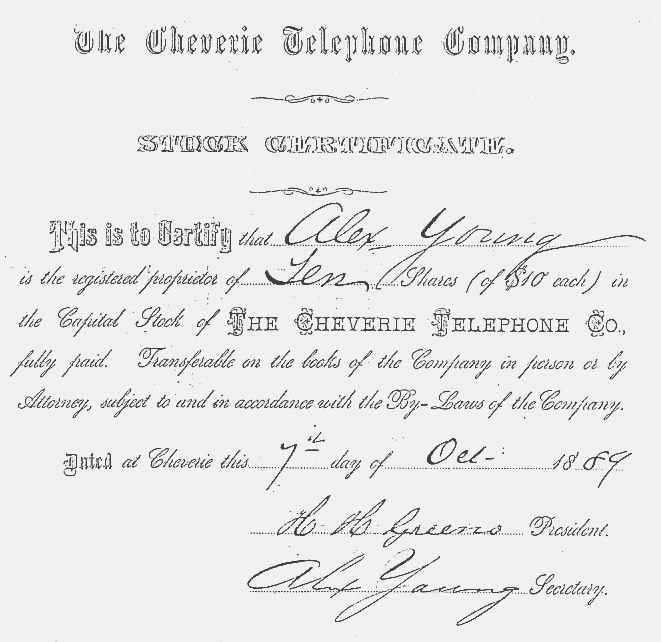
Cheverie Telephone Company
share certificate, 1889
The original is held by the West Hants Historical Society, Windsor.
(These ten links work properly after this page has downloaded completely.)
• #
Government-Owned Telephone and Telegraph Companies
• #
Privately-Owned Telephone and Telegraph Companies
• #
Mutual Telephone Companies Under the Rural Telephone Act
• # Number of Telephone Companies
Operating in Nova Scotia, Year by Year
• # Links to Telegraph History Websites
• # Links to Telephone History Websites
• # Recent additions to this list
• # Telephone Exchange names
• # Fire Numbers before 911
• # Notes
| ||||||||||||||||||||||||||||||||||||||||||||||||||||||||||||||||||||||||||||||||||||||||||||||||||||||||||||||||||||||||||||||||||||||||||||||||||||||||||||||||||||||||||||||||||||||||||||||||||||||||||||||||||||
The 1976 Statistics Canada report lists 806 separate telephone companies operating within Canada.
[Source: Long Distance Please: The Story of the TransCanada Telephone System (book) by E.B. Ogle, Collins Publishers, 1979, ISBN 0002161672]
The large number of telephone companies that sprang up in Nova Scotia was not unusual.
"From 1894 to 1903, an estimated 20,000 telephone companies were started in the United States."
[The National Post, 4 March 2000]
The Nova Scotia assets of the Dominion Government Telegraph & Telephone Service were acquired by MT&T in 1960.
Source: PUB Annual Report 1960, page xxxiii
Alfred Dickie (1860-1929) was a prominent lumber merchant and businessman in Stewiacke, Nova Scotia. One of his business interests was the Alfred Dickie Lumber Company, another was the Colchester Steamship Company Limited of Lower Stewiacke, and yet another was the Grand River Pulp and Lumber Company Limited of Labrador.
In 1902 the Newfoundland government granted a fifty-year timber concession on both sides of the Hamilton River in Labrador (297 square miles 770 square kilometres) to Dickie's Grand River Pulp and Paper Company, which promptly started a substantial timber harvesting and saw-milling enterprise. The company developed two company centers of operation, one at Mud Lake (renamed Grand Village by the company) and another 20 miles to the east at Kenemich. These sites included: lodgings, a school, stables, smithy, and company store. This company issued its own coinage and bills, brought ships of 2000 tons within close anchorage of the mills, and by 1909 exported 12 million board feet of lumber. During the Dickie company's activities, the Quebec Government of 1902 sent surveyors by ship to mark the logs "P.Q.", and then challenged the legality of the cutting license. This precipitated the Labrador Boundary Case between Canada and Newfoundland, which was finally resolved in 1927 by the Imperial Privy Council.
[Excerpted from http://www.central-labrador.nf.ca/history.htm and other sources.]
Rufus Edward Dickie (1886-1972) was a prominent lumber merchant and businessman in Stewiacke.
To Managers Offices Nova Scotia District:
The following rules will be observed regarding
all messages passing over the Atlantic Cable.
Tariff from all parts of Nova Scotia is fixed as follows:
|
The first 20 words to include address of sender and receiver, but not to exceed 100 letters, and if the number of letters exceed 100, the excess will be divided by five and each 5 letters or fractional remainder be charged as an additional word. The letters in all words after the first 20 will be counted and divided by five, each five or fractional remainder will be charged as a word.
Messages in cipher will be charged double the foregoing rates. All figures intended for transmission must be written in full length, and will be charged as words. Messages destined for places beyond the telegraphic system will be forwarded by mail.
All messages must be prepaid.
You will keep a totally distinct and separate record of all Atlantic Cable business, forward an accurate statement of receipts and checks, together with all money received on this account, to the Cashier and Auditor at Halifax, by mail at the end of each week. This business is not to be put in the regular monthly accounts.
In preparing weekly accounts state in detail date, address, signature and number of words in each message.
Alex. E. Hoyt
Asst. Superintendent
[The above is quoted whole, from the original document.]
Additional information about the transatlantic telegram business
http://epe.lac-bac.gc.ca/100/205/300/nova_scotias_electronic_attic/07-04-09/www.littletechshoppe.com/ns1625telegraph02.html#atlanticrates1866
The Antigonish & Sherbrooke Tel. Co. began operating in late May 1904.
— Source: Pages 799-800 of the Report of of the Select Committee appointed to inquire into the Various Telephone Systems in Operation in Canada and Elsewhere, Session No. 24, May 17, 1905, House of Commons, Ottawa
Known to have been in operation in 1904-05. See
Winfield's list.
In January 1922, the PUB reported that the Barrington Township Tel. Co. "operates two exchanges, one at Clarks Harbour and the other at Barrington, and owns about 90 miles 145 km of black spruce pole line ... generally in good condition. The system also embraces considerable cable laid and maintained by the Federal Government in order to afford telephonic connection to certain islands. There are 36 circuits; 16 connecting with the Clarks Harbour exchange and 20 with the Barrington exchange. All of these, with two exceptions, are metallic circuits and carry in all 179 stations (telephones). Of the two grounded lines, one connects with a single core cable and as soon as the company is able to induce the Federal Government to lay twin-core or second single-core cables it is proposed to make these two circuits metallic." Barrington Township Tel. Co. rates, taking effect 1 January 1922, were:
|
Emergency Service shall be furnished between the hours 9:00pm and 11:00pm during March, April, and May each year at 15 cents per message, in addition to the regular rate.
The Belleville Rural Tel. Co. "operated 22 miles 35 km of line, two wires on hackmatack poles." It connected to the North American telephone network at Tusket.
On 3 December 1965, the Belleville Rural Tel. Co. sold its entire undertaking, including rights-of-way, plant, apparatus, and equipment, all in working order, to MT&T. On the same day, the Belleville Rural Tel. Co. abandoned its territory and went out of business forever.
Sources: The Halifax Chronicle-Herald 20 March 1999, and records of the Public Utilities Board
On 28 November 1887, the Bell Telephone Company sold its telephone and telegraph operations in Nova Scotia and New Brunswick to the Nova Scotia Telephone Company.
[National Post, 28 November 2000]
Known to have been in operation in 1904-05. See
Winfield's list.
The Blandford Tel. Co. is named in the 1912 Annual Report of the Public Utilities Board, in the list of Private Utilities, Telephone Companies. (The 1912 list is the earliest published by the Public Utilities Board.) The Blandford Tel. Co. appears in each of the P.U.B.'s annual lists from 1912 through 1943. It does not appear in the 1965 list.
In 1912, the Brooklyn Tel. Co. reported total gross (before expenses) operating revenue of $947.80, for the year.
The Carleton Tel. Co. supplied telephone service in a large territory north and east of the Town of Yarmouth. It connected to the North American telephone network at the MT&T Yarmouth Exchange.
|
The PUB Annual Report of 1958 says the Carleton Tel. Co. "began operations in 1918," but it appears the company was in operation much earlier. J. Murray Lawson, in his book Yarmouth Reminiscences, published in Yarmouth in 1902, states that the Carleton Tel. Co. was organized on 11 February 1884, and required an increase in its capital in August 1895, which strongly indicates the company's system was then in operation. Murray Lawson was the son of Alexander Lawson, who was the owner and editor of The Yarmouth Herald 1833 - 1895; the book Yarmouth Reminiscences consists mainly of items gleaned from back issues of the newspaper, which provide contemporary reports of events, and Alexander Lawson was careful with his facts. While the Public Utilities Board was always meticulous about getting its facts right, and in case of a conflict between the PUB and another source I would normally choose to believe the PUB's version, in this particular case I think that Murray Lawson's version has to be given credence. Lawson reports that the first Directors were S.M. Ryerson, President; Edwin Crosby, Secretary-Treasurer; W.H. Miller, A.R. Durkee, and Nathan Hilton. ICS |
On 7 November 1922, the PUB officially approved the following operating schedule for the Carleton Tel. Co.:
|
On 3 September 1958, the Carleton Tel. Co. sold its entire undertaking, including plant, apparatus, equipment in service, rights-of-way and goodwill, to MT&T for $7,700.00. On the same day, the Carleton Tel. Co. abandoned its territory and went out of business forever. At the time of the shutdown, the Carleton Tel. Co. had 83 subscribers served by two circuits on about 49 miles 79 km of pole line. The poles carried 23,000 pounds 10,000 kg of number 9 iron wire which was "badly pitted and rusted". 14,000 pounds 6,000 kg of this wire was considered to be worthless, while the remaining 9,000 pounds 4,000 kg "would probably give service for another three or four years".
Known to have been in operation in 1904-05. See Winfield's list.
Known to have been in operation in 1904-05. See Winfield's list.

In 1912, the Clam Harbour and Owls Head Tel. Co. reported total gross (before expenses) operating revenue of $44.00, for the year.
— Source: PUB Annual Report 1912
In 1960, the Clam Harbour and Owls Head Tel. Co. ceased operation and abandoned its territory. Telephone service in this area was taken over by MT&T.
— Source: PUB Annual Report 1960
The Coastal Tel. Co. was incorporated 11 July 1907.
The Coastal Tel. Co. reported, for the year 1912, a total operating revenue of $673.25 and operating expense of $359.00, and it paid dividends of $120.00 on capital stock of $2,000.00.
On 7 July 1958, the Coastal Tel. Co. sold its entire undertaking, including plant, apparatus, equipment in service, rights-of-way and goodwill, to MT&T for $1,500.00.
On 9 November 1958, the Coastal Tel. Co. abandoned its territory and went out of business forever. At the time of the shutdown, the Coastal Tel. Co. served 75 subscribers on five circuits, with 35.2 miles of pole line carrying 93.3 miles of circuit; the rate was $2.50 per month for party line service. The shutdown was precipitated by the company's "inability to cope" with "the very rapid expansion of the district subsequent to World War Two, (which) presented the company with steadily increasing demands for extended service (which were) beyond its resources".
— Source: PUB Annual Reports, 1912 and 1958
The Commercial Cable Company was incorporated in New York in 1883 by John William Mackay (1831-1902) and James Gordon Bennett (the younger) (1841-1918).
Commercial Cable Company, historical notes
http://epe.lac-bac.gc.ca/100/205/300/nova_scotias_electronic_attic/07-04-09/www.littletechshoppe.com/ns1625telegraph02.html#commcabstart
Known to have been in operation in 1904-05. See Winfield's list.
The Cumberland Rural Tel. Co. reported, for the year 1912, a total operating revenue of $186.25 and operating expense of $360.00.
As of 19 December 1961, the Cumberland Rural Tel. Co. had this schedule for Regular Hours of Service:
|
The charge for Emergency Service shall be 25 cents per call, in addition to all other charges. The Emergency Charge shall be paid on all calls received or delivered outside of the Regular Hours of Service.
— Source: PUB Annual Report 1961
Agreement between the District Five Telephone Company and the Nova Scotia Telephone Company, dated March 22, 1905, terminable on one year's notice.
The District Five Telephone Company shall purchase the telephone plant now owned by the Nova Scotia Telephone Company, carried on District Company's poles, twelve miles, in all, and pay therefore one hundred and forty-five dollars ($145), the Nova Scotia Telephone Company to apply and maintain either Byng or Blake bridging and telephones at a rental of $15 per annum to members of the District Company, the latter company to provide and maintain the lines. Long-distance transmitters charged $5 per annum additional.
Nova Scotia Company shall hand over to the District Company (less the agent's comission of 20 per cent) fifteen cents per conversation from parties in the River Hebert exchange. The Nova Scotia Company's subscribers to have the option to pay the District Company a flat rental of five dollars for residence and seven dollars and fifty cents for business instruments, (less the agents commission of 20 per cent) in lieu of the aforesaid tolls.
The District Company to charge ten cents on all long-distance messages over their lines to non-subscribers, to be collected by the Nova Scotia Company's agents for 20 per cent commission. The District Company shall not extend their line beyond Polling District No. 5 or connect with any other line or company without the consent of the Nova Scotia Company.
— Source: Report No. 16, 2 May 1905, of the Select Committee Appointed to Inquire into the Various Telephone Systems in Operation in Canada and Elsewhere, Ottawa
|
The Dominion Chair Company has had six factories in Bass River since 1860 when the first factory was built and operated as the Union Furniture and Merchandise Company. Each time the factories have burned down. The last factory burned on 5 February 1989 and has never been rebuilt. Source: http://www.atnazarene.org/photo/album2/bassrv.html |
Known to have been in operation in 1904-05. See Winfield's list.
The East Pictou Telephone Company, which is planning to construct a telephone line to Little Harbour and points on the coast of East Pictou, is now fully organized and will start construction at once. The President of the Company is Mr. Charles P. Stewart, Little Harbour, and the Secretary is Councillor Frank McNeil, New Glasgow. Mr. James McKay, of East River, St. Mary's, is engaged to superintend the erection of the poles. There will be a call station at Fisher's Grant or some other place just below Trenton that will be "called" by the Nova Scotia Telephone Company and that station will call up subscribers beyond.
[New Glasgow Eastern Chronicle, 21 June 1907, page 8]
Known to have been in operation in 1904-05. See Winfield's list.
Known to have been in operation in 1904-05. See Winfield's list.
Known to have been in operation in 1904-05. See Winfield's list.
The Grand Mira Tel. Co. reported, for the year 1912, a total operating revenue of $228.64 and operating expense of $28.40.
— Source: PUB Annual Report 1912
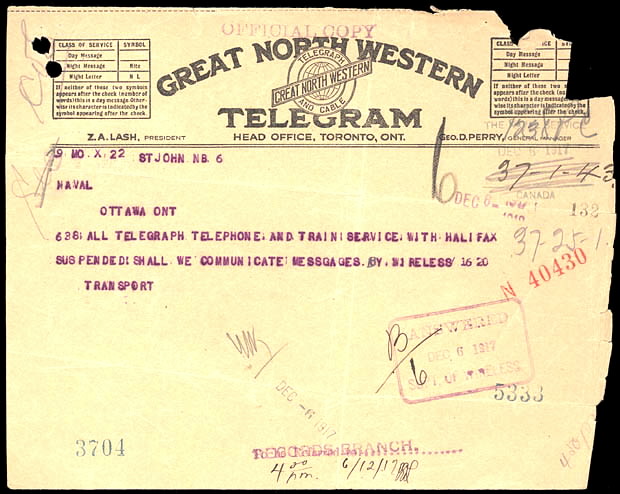
All telegraph telephone and train service with Halifax
suspended! Shall we communicate messages by wireless.
The main interest here is the association of this telegram with the 1917 Halifax Explosion. However, there is an interesting detail — the name Z.A. Lash, shown on this printed telegraph form as President, Great North Western Telegraph and Cable Company. Although his name is almost unknown among Canadians, no adequate history of Canada can be written without Zebulon Acton Lash (1846-1920) appearing significantly in it. Very briefly, in the 1870s Z.A. Lash was Deputy Minister in the Department of Justice in Ottawa; in the late 1890s he was deeply involved in the formation of the Canadian Northern Railway; for more than a decade, beginning in 1902, he was chief solicitor for MacKenzie, Mann and Company Limited (at the time when this company was organizing and building the Halifax & South Western Railway in Nova Scotia, among other important projects); when Robert Borden became Prime Minister in 1911, Lash advised him on the formation of the cabinet, and then served as Borden's legal counsel on the organization of Canadian National Railways. Lash's activities were far more extensive and influential than this short note indicates.
In 1884 A Royal Commission recommended that there should be a direct cable between the West Indies and Halifax, Nova Scotia. In 1889 the British Government decided to go ahead with the project and link the naval base at Nova Scotia with the British Naval harbour at Hamilton, Bermuda. The Halifax & Bermudas Telegraph Company was established to carry out the work which was put out to tender with the promise of a twenty-year subsidy.
On July 7th, 1890, cableship SS Westmeath sent the southern end, of the cable from Halifax, ashore at Cable Beach in Bermuda. The next day, July 8th, the Hamilton, Bermuda, telegraph office was connected to Halifax by the new undersea cable. On July 10th, 1890, a telegraph message was sent to HM Queen Victoria from the Governor of Bermuda. On July 14th, 1890, the cable telegraph service was opened to the public at Hamilton.
In April, 1929, some thirty British telecommunications companies throughout the world — including the Halifax & Bermudas Telegraph Company — merged into one company registered in London and named Imperial & International Communications Limited. In 1935 a working agreement enabled the West India & Panama Telegraph Company to take over the operating assets of the Halifax & Bermudas company and in 1939, the parent company became part of Cable & Wireless (West Indies) Limited.
Sources:
http://www.cwhistory.com/history/html/HALBERTCO.html
http://www.cwbda.bm/education/history.htm
Known to have been in operation in 1904-05. See
Winfield's list.
In 1912, the Hammonds Plains Tel. Co. reported total gross (before expenses) operating revenue of $96.05, for the year; there was no report of the operating expenses.
Agreement between the Hammonds Plains Telephone Company and the Nova Scotia Telephone Company, dated May 23, 1902, for a term of three years.
The companies agree to receive, transmit and deliver the messages of the subscribers of their respective companies. The charge to and from Halifax being ten cents and beyond Halifax the tariff of the Nova Scotia Telephone Company in addition thereto.
Neither parties are to compete with each other within the territory now occupied by them respectively nor shall they make connections with any telephone company or corporation operating in competition with the Nova Scotia Telephone Company or the Hammonds Plains Company. The Nova Scotia Company to have the first option of purchase of the Hammonds Plains Company. The Hammonds Plains Company shall not purchase or use any instruments or apparatus but the standard 'Bell' these to be purchased from the Nova Scotia Company.
— Source: Report No. 16, 2 May 1905, of the Select Committee Appointed to Inquire into the Various Telephone Systems in Operation in Canada and Elsewhere, Ottawa
A Petition of Benjamin DeWolfe and others, inhabitants of Windsor, and others residing within the Province of Nova Scotia, was presented by Mr. Fraser, and read, praying for the passage of an Act to Incorporate a Company for the purpose of erecting a Line of Electric Telegraph between Windsor and Halifax, and for pecuniary aid to the undertaking out of any surplus funds arising from receipts from the Provincial Line of Telegraph.
— Source: Journal and Proceedings of the House of Assembly Halifax
23 January 1851, pages 622-623
Mr. Fraser, pursuant to leave given, presented a Bill to Incorporate the Hants and Halifax Electric Telegraph Company; and the same was read a first time and ordered to be read a second time.
— Source: Journal and Proceedings of the House of Assembly Halifax
23 January 1851, page 623
A Bill to Incorporate the Hants and Halifax Electric Telegraph Company was read a second time. Ordered: That the Bill be referred to Mr. Fraser, Mr. McLeod, Mr. Killam, Mr. Whitman and Mr. Marshall, to examine and report on, with amendments or otherwise.
— Source: Journal and Proceedings of the House of Assembly Halifax
23 January 1851, page 623
The Lake LaRose Rural Tel. Co. was organized in 1912.
On 4 June 1961, the Lake LaRose Rural Tel. Co. sold its entire undertaking, including plant, apparatus, equipment in service, rights-of-way and goodwill to MT&T. On the same day, the Lake LaRose Rural Tel. Co. abandoned its territory and went out of business forever.
— Source: PUB Annual Report 1961
In December 1912, the Lawrencetown Telephone Company (not then "Limited", that is, not legally incorporated) was operating a single circuit party line about 20 miles long "fully loaded" with about 30 subscriber telephones.
The Maitland & Noel Tel. Co. began operating a telephone service in this area about 1890. Known to have been in operation in 1905 with ten subscribers (see
Winfield's list).
In 1961, the Maitland & Noel Tel. Co. was owned by Mr. Aubrey Scott and two other shareholders. On 19 December 1961, the Maitland & Noel Tel. Co. abandoned its territory and went out of business forever. The company's territory was split into two parts, with the boundary line located 4.1 miles 6.6 km from Tennycape River towards Walton near Mr. Stanley Crossley's store. The location of this boundary was decided by majority subscriber preference as determined by a canvass of each subscriber. The entire undertaking east of this boundary, including plant, apparatus, pole lines, rights-of-way, and equipment in service, all in working order, was sold to MT&T for $3,767.50. The entire undertaking west of this boundary, including plant, apparatus, pole lines, rights-of-way, and equipment in service, all in working order, was sold to the West Hants Telephone Company Limited for $500.00. At the time of the shutdown, M&NT Co. had 72 miles 116 km of pole line and 130 miles 209 km of wire serving 293 subscribers.
— Source: PUB Annual Report 1961
The Maple Leaf MT Co. was incorporated in 1908.
In 1912, the Maple Leaf Tel. Co. reported total gross (before expenses) operating revenue of $934.53, for the year.
In April 1958, the Maple Leaf MT Co. was operating nine circuits on about 65 miles of pole line with about 115 miles of metallic circuit serving 85 subscribers, "a substantial drop from the 112 reported some two years previously". At a Public Utilities Board hearing in New Glasgow, on 16 April 1958, a subscriber on Line One testified that his telephone had been out of service 50% of the time during the last ten years, and to an even greater extent in the most recent years. "Even when the line is in operation signals are weak and messages must frequently be relayed". This evidence was supported by other complainaints, "who indicated that long journeys were often necessary in matters of urgency... due to failure of the telephone service". "Some of the present difficulties have been aggravated by highway construction in the area in recent years, with the consequent disruption of lines...".
The President of the Company agreed that the complaints were substantially correct. "He stated that the matter was chiefly one of finance, and that the Company had so far been unable to raise the $4,000 or so estimated as the minimum required to put the Company's circuits in reasonably good condition". The Company Secretary, who was also the lineman, testified that the Company's equity was divided equally among 700 shares (which represented the entire ownership), and to borrow money it was necessary to obtain the approval of the holders of 75% of the shares, but as 60% of the shares were owned outside the Company's territory, it had been found very difficult to obtain such approval. The President was of the opinion that "the Company would not willingly abandon" its territory.
After hearing this testimony, the Public Utilities Board ordered that a meeting of the Company's shareholders be held, to consider these problems. This meeting was held on 24 May 1958 at the Lower Barney's River Hall; a motion to borrow $4,000 to repair and rebuild the Company's lines was defeated by a share count of 63 shares in favour and 375 shares against. "No mover or seconder was found to sponsor a motion" to sell the Company, "nor was there any support for the suggested formation of a Mutual Telephone Company".
On 21 July 1958, the PUB issued a formal order, that the Company was to "put its lines in condition to render adequate service in its territory in accordance with Section 48 of the Public Utilities Act", and that the necessary construction and repairs had to be completed before 31 December 1958.
— Source: PUB Annual Report 1958
In 1912, the Mapleton Rural Tel. Co. reported total gross (before expenses) operating revenue of $8.60, for the year.
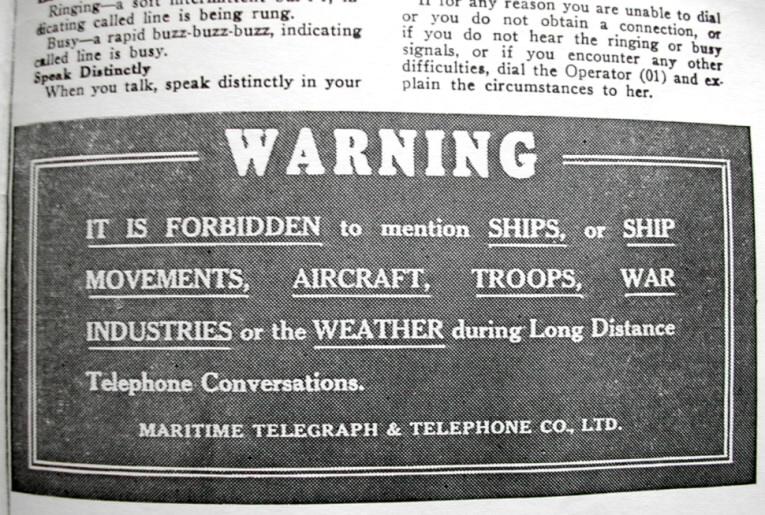
During the spring of 1916, this territory was taken over by the Wedgeport Tel. Co., which purchased the telephone lines and submarine cables originally owned by the Murray Tel. Co., between Wedgeport and Comeau's Hill, consisting of about 12 miles of pole line and 2 miles of submarine cable.
On 19 May 1922, the Musquodoboit Harbour Rural Tel. Co. received official approval that the company's proportion of Local Call and Long Distance charges for messages to or from any point on its line would be 5 cents.
— Source: PUB Annual Report 1922
The New Cumberland Telephone Company is known to have been carrying on a telephone business in 1905 and 1906 — it appears as "Cumberland Telephone Company" in Winfield's list dated May 1905, and it was involved in a lawsuit in 1906.
The New Cumberland Tel. Co., incorporated and doing business in Nova Scotia, was the plaintiff in a lawsuit against two telephone companies incorporated and doing business in New Brunswick, the Central Telephone Company with head office in Sussex, and the New Brunswick Telephone Company with head office in Fredericton.
On 15 June 1906, the New Cumberland Company entered into a written agreement with the Central Company for the transmission of messages over the lines of both companies, between all points in Nova Scotia reached by the New Cumberland system, and all points in New Brunswick reached by the Central system. By the terms of the agreement, which was to be in force for ten years, it was agreed that each company should provide the use of its lines and equipment and the services of its employees for the purpose of the joint business, and also the use of any connections which either of the companies then had or might thereafter acquire over the lines of any other company doing business in either of the two provinces. The tolls to be charged were not fixed by the agreement, nor was any basis determined for their division between the parties; but it was agreed that the rates were to be fixed at a later date by the managers or other officers of the companies, and they were to continue in force for the ten years or until changed by a mutual agreement between the companies.
In September 1906, three months after this agreement was signed, the New Brunswick Telephone Company bought from the Central Company all its property both real and personal, including all poles, rights of way, wires, telephones, and all other property of every kind and description. The New Brunswick Telephone Company, the new owner of the former Central Company system, recognized the agreement between Central and the New Cumberland Company, but planned to implement it only within the area served by the former Central Company on 21 August 1906, while the New Cumberland Company insisted that it be extended throughout the New Brunswick Telephone Company system. When the New Brunswick Telephone Company refused to agree to this extension, the New Cumberland Company went to court in New Brunswick and obtained an interim injunction on 25 September 1906, preventing the completion of the proposed sale of the Central system. On 17 November 1906, Justice Barker of the New Brunswick court issued a decision refusing to extend the temporary injunction.
— Source: Excerpted from the decision by Justice Barker of the New Brunswick court dated 17 November 1906, in the case of New Cumberland Telephone Company versus Central Telephone Company and New Brunswick Telephone Company, as reported on pages 101-105 of the Eastern Law Reporter, volume II number 3, 1 December 1906, published by the Carswell Company, Toronto.
In 1922, the New Ross Tel. Co. connected to MT&T at two locations: Chester Basin in Lunenburg County, and Springfield in Annapolis County.
Winfield's list reports that the New Ross Tel. Co., had just three telephones in operation, in the spring of 1905.
Agreement between the New Ross Telephone Company and the Nova Scotia Telephone Company, dated December 1, 1904, for a term of three years.
The companies agree to receive, transmit and deliver the messages of the subscribers of their respective companies.
The charge between the New Ross Company's lines and Chester Basin shall be 10 cents, to go to the New Ross Company. Between the New Ross Company and the Chester Basin Exchange (excepting Chester town, 25 cents), 20 cents, 5 cents of which goes to the Nova Scotia Company. Between the New Ross Company and any other point, 15 cents, plus the Nova Scotia company's rates from Chester Basin, of which the New Ross Company takes 15 cents. The New Ross Company to pay the Nova Scotia Company five dollars ($5.00) per annum for each instrument connected with their line.
Neither parties are to compete with each other within the territory now occupied by them respectively nor shall they make connections with any telephone company or corporation operating in competition with the Nova Scotia Telephone Company or the New Ross Company. The Nova Scotia Company to have the first option of purchase of the New Ross Company. The New Ross Company shall not purchase or use any instruments or apparatus but the standard 'Bell', these to be purchased from the Nova Scotia Company.
— Source: Report No. 16, 2 May 1905, of the Select Committee Appointed to Inquire into the Various Telephone Systems in Operation in Canada and Elsewhere, Ottawa
| The December 1, 1904 Agreement (above) specifies that the charge for a telephone call between Chester and New Ross (or any other point on the New Ross Company lines) will be 25 cents, 5 cents of which goes to the Nova Scotia Telephone Company. The reason for this division of charges is that the line between Chester and Chester Basin was owned and operated by the Nova Scotia Telephone Company, and the line north from Chester Basin was owned and operated by the New Ross Company. |
The New Tusket Rural Telephone Company was an unincorporated organization, with the sole owner, in 1961, being Mr. J. Eldon Ford. On 1 July 1961, New Tusket Rural Tel. Co. increased its rates from $2.00 per month to $2.25 per month; it was then operating six circuits serving 58 customers.
— Source: PUB Annual Report 1961
On 1 July 1962, the New Tusket Rural Tel. Co. sold its entire undertaking, including plant, pole lines, rights-of-way, apparatus, and equipment in service — all in working order — to MT&T for $756.00. On the same day, the New Tusket Rural Tel. Co. abandoned its territory and went out of business forever. At the time of the shutdown, the Company was operating 26 miles 42 km of pole line, supplying dial telephone service to 30 subscribers on three circuits, and magneto service to 30 subscribers through a manual switchboard located in Mr. Ford's residence in New Tusket.
— Source: PUB Annual Report 1962
1853 January 23: A petition of F.N. Gisborne, on behalf of the provisional directors and stockholders of the
Nova Scotia & Newfoundland Junction Telegraph Company was presented by Mr. Weir, and read, praying for the passage of an act to incorporate that company.
Ordered that the petition do lie on the table.
Mr. Weir, pursuant to leave given, presented a bill to incorporate the Nova Scotia & Newfoundland Junction Telegraph Company — and the same was read a first time and ordered to read a second time.
— Source: Journal and Proceedings of the House of Assembly Halifax
Session 1853, page 226
CIHM: 9_00946_104
1853 March 2: The special committee to whom was referred the bill to incorporate the Nova Scotia & Newfoundland Junction Telegraph Company, and the several petitions connected therewith, beg leave to report: that having examined witnesses and investigated the subject referred to them, the committee do not recommend the bill to the House.
All which is respectfully submitted.
Signed
Hugh Munro, chairman
John J. Marshall
Thomas Killam
— Source: Journal and Proceedings of the House of Assembly Halifax
Session 1853, page 292
CIHM: 9_00946_104
Known to have been in operation in 1904-05. See Winfield's list.
The Paradise West Tel. Co. was organized in 1909 by twelve residents of the district, each member contributing $30.00 in cash or materials, necessary for the construction of 3.5 miles 5.6 km of telephone line; it connected to the North American telephone system at the MT&T Bridgetown Exchange.
Known to have been in operation in 1904-05. See Winfield's list.
A petition of Hiram Hyde of Truro, in the County of Colchester, was presented by the Hon. Mr. McKeagney, and read, praying for the passage of an Act to Incorporate a Company for the purpose of constructing a Line of Electric Telegraph from Pictou to the Gut of Canso, and thence to Sydney, Cape Breton.
— Source: Journal and Proceedings of the House of Assembly, Halifax
1 February 1851
The name of the Port LaTour Telephone Company appeared in the Halifax Chronicle-Herald on 19 February 1997, in the obituary of Willard Maxwell Nickerson, 84, of Port La Tour, Shelburne County, former manager of the company.
Known to have been in operation in 1904-05. See Winfield's list.
The Riverport Telephone Company was organized in 1893. Telephone lines were put through the district and three battery operated telephones were installed. One in Samuel Ritcey's general store, Riverport, at Isaac Heckman's shoe store, Rose Bay, and another at Rufus Mossman's store in Lower Kingsburg. A telephone exchange was operated from the home of Asaph Conrad. Dial telephones came into the area in 1938.
Source:
http://homepages.rootsweb.com/~downhome/riverport.html
Gertrude Parker was born on October 12, 1892 in Westmount, Montreal, Quebec. Her father was the Captain of the Fire Department in Westmount. She married and moved first to Halifax and then became one of Sackville's early residents in 1945. She had seven sons and one daughter. She lost one son during World War Two.
In 1946, Mrs. Parker took over the Sackville telephone switchboard from Mrs. Daisy Weir. This switchboard was the old magneto type with a crank. She operated it for the Maritime Telephone and Telegraph Company which took charge of it that year. She directed calls on her switchboard 24 hours a day from her home, receiving the salary of $13.00 per month, charging 25 cents to anyone making a night call.
In 1946, Sackville's telephone system had fewer than fifty telephone subscribers (customers). In the late 1940s and through the 1950s, these customers were served by six to eight party lines, operated by Mrs. Parker, which supplied the only telephone service available in those days between Bedford and Hants County line, including Beaver Bank and Lucasville.
By the early 1960s, Sackville's telephone system had grown to approximately 300 lines (customers), requiring three large switchboards at Mrs. Parker's home. Several operators took shifts on the switchboards and Mrs. Parker took the overnight calls.
Perhaps her most important duties involved the fire service in Sackville, which in the beginning was a volunteer bucket brigade. These volunteers were called by Mrs. Parker (using special line number 3) for such events as a barn or a house fire. There were occasions when the Sackville volunteers required more men and Mrs. Parker would put a call through to the Bedford fire service. Both fire services came to each other's aid during those years, a tradition that grew to make the two departments quite close.
As fire dispatcher, Mrs. Parker and her family became very involved in the development of the department in Sackville, which was established in 1955. Her family members were volunteers and have held various positions (including Chief) over the years. This tradition continues to this day (1996).
Mrs. Parker is most remembered for directing household and emergency communications in Sackville until 1963. That year the Maritime Telephone and Telegraph Company introduced the dial telephone to Sackville and her switchboard was no longer required. Mrs. Parker retired and though later confined to a wheelchair, kept active over the years with the many friends she made as telephone operator. She is remembered for her helpful, gracious, lady-like character and positive personality.
On June 13, 1980 Gertrude Parker died and her many friends and acquaintances paid tribute to her. The Maritime Telephone and Telegraph Company and the Sackville Fire Department, in particular, recognized her years of service.
The students and staff of our school wish to say THANK YOU to the family of Gertrude Parker for the framed photograph of their mother and grandmother, which our school board will mount for display outside our office.
Mrs. Parker made significant contributions to the residents of Sackville for over thirty years. We are proud of the role that she played in the history of Sackville and we are proud that our school is named after her.
Source: Gertrude Parker Elementary School's website, April 2004
http://www.gpes.ednet.ns.ca/Mrs.%20Parker1.htm
On 1 March 1961, the Salem Rural Tel. Co. sold its entire undertaking, including plant, apparatus, pole lines, rights-of-way, and equipment in service, all in working order, and goodwill to MT&T for $300.00. On that same day, the Salem Rural Tel. Co., which had been operating a telephone service since about 1910, abandoned its territory and went out of business forever.
— Source: PUB Annual Report 1961
In 1960, the Sandford & Short Beach Rural Tel. Co. ceased operation and abandoned its territory. Telephone service in this area was taken over by MT&T.
— Source: PUB Annual Report 1960
In 1922, the wires of the Blue Mountain MT Co. from Kentville to "Patterson's", a distance of about six miles ten km, were carried on poles owned by the South Alton Rural Tel. Co., and Blue Mountain MT Co. paid South Alton the "ordinary pole rental" rate.
These are three versions of the name of one telephone company. All three appear from time to time in the Annual Reports of the PUB, from 1912 to 1960. The name "Surette's Island Rural Telephone Company" usually appears in the more formal proceedings, such as PUB Orders establishing the company's rates and the closure hearing in 1960. The other versions usually appear in the routine annual list of reporting companies, which was proofed less rigourously than the important formal legal reports. On modern maps issued by the provincial government, the name of the community "Surette's Island" is spelled with a single "r". In the PUB reports the name of the telephone company is spelled sometimes with a double "rr", "Surrette's Island", and sometimes with a single "r". This leaves us with six different spellings of the name of this one telephone company, all appearing at one time or another in the official PUB annual reports, with different spellings occasionally appearing on the same page. In the absence of a legal incorporation document (see below, "not incorporated..."), there seems to be no way to decide which spelling is correct. Because the spelling with "Rural" usually appears in the reports of significant formal proceedings, I have chosen this version to use as the name for this company.
— ICS, 18 April 2005
|
Surrette's Island Rural Telephone Company
for the year 1914:
Capital Stock $400.00
Operating Revenue $153.03
Operating Expenses $ 25.11
Source: PUB 1914 Annual Report, page 119
Surrette's Island Rural Telephone Company
for the year 1916:
Capital Stock $400.00
Operating Revenue $195.61
Operating Expenses $ 72.45
Dividends Declared $ 83.00
Source: PUB 1916 Annual Report, page 111 schedule G
|
The Surrette's Island Rural Telephone Company is listed in each of the Annual Reports of the Public Utilities Board from the first in 1912 to 1960, inclusive. So far, no information has been found about when the company started operation — it seems likely that it was supplying telephone service in the area a few years before 1912, but it is missing from
Winfield's list of telephone companies in existence in Nova Scotia in May 1905.
The Surrette's Island Rural Telephone Company's single party line circuit connected with the North American telephone network at MT&T's exchange at Tusket.
On 4 November 1960, Surrette's Island Rural Telephone Company (SIRT) sold its entire undertaking, including rights-of-way, plant, apparatus, and equipment, all in working order, to MT&T for $150.00. On the same day, SIRT abandoned its territory and went out of business forever. At the time of the shutdown, SIRT served 23 subscribers on one circuit about 11 miles 18 km long.
Before SIRT's assets could be sold, and the territory transferred to MT&T, approval of the Public Utilities Board was required. The PUB held a public hearing at the Court House at Yarmouth, on June 6th, 1960, "after due public notice." MT&T was represented by its General Counsel and Secretary, Mr. Struan Robertson. SIRT was represented by its President, Mr. Philomon Pottier. Mr. Frank Amirault, a shareholder of SIRT was also present.
In its report, issued after this public hearing, the PUB described the Surrette's Island Rural Telephone Company as "not incorporated but is of the nature of a partnership with 34 owners, doing business in the County of Yarmouth." Both MT&T and SIRT "are public utilities within the meaning of the Public Utilities Act in the supply of telephone service in the Province of Nova Scotia."
SIRT "first approached MT&T in January 1958, indicating a desire to sell its undertaking. Due to heavy committments in 1958, MT&T was unable to complete its canvass of the area until the spring of 1959, although a preliminary survey was made in May 1958. As a result of the 1959 canvass, MT&T received 76 applications for service, including all 23 of SIRT's present subscribers."
"An inventory of SIRT's system was made following the canvass which involved a physical count of poles, telephone sets, wire, etc., and it was indicated that the only items of value that could be used by MT&T were four telephone sets and one bracket, which were valued at current cost new, less depreciation. Pursuant to this valuation, an offer of $150.00 was made to SIRT in August 1959, and accepted the following month."
"Capital construction to the extent of some $21,000 is forecast by MT&T regarding new pole lines, cables, etc., required to provide an adequate standard of service in the area. MT&T expects that this construction will be completed by November 1960 if the Application is approved, and have suggested November 4th, 1960 as the effective date of the within applications, which date coincides with SIRT's billing date. In the meantime MT&T is rendering assistance to SIRT at present in order to provide temporary facilities due to the need to move pole lines because of highway work in the district; this work will cost about $1,000, according to MT&T's estimate."
"By an indentspecialure of Sale dated May 2nd, 1960, 32 of the 34 owners of SIRT have agreed to the sale of its property, effects and undertaking to MT&T for the sum of $150.00 aforesaid. Mr. Pottier in evidence confirmed that the said 34 persons are the actual owners of SIRT and those owners who have not signed are Mr. Lawrence Amirault, now living in the United States whom they have been unable to locate as yet, and the Heirs of Albert Pottier, which estate has not been administered. The share of these parties will be paid to them by SIRT in due course according to the testimony of Mr. Pottier."
The Public Utilities Board found that these plans for the sale of the Surrette's Island Rural Telephone Company's property and the abandonment of its territory, and the takeover of the territory by MT&T were "in the best interests of good telephone service in the area and that the terms are fair and just in the circumstances..." The PUB gave its approval, dated 2 August 1960, to become effective on and from November 4th, 1960.
— Source: PUB Annual Report 1960, pages 189-93.
Contract between the Union Furniture and Merchandise Company of Bass River, N.S., and the Nova Scotia Telephone Company, dated June 1, 1902, for a term of three years.
The companies agree to receive, transmit and deliver the messages of the subscribers of their respective lines. The charge to and from the Union Furniture and Merchandise company's lines shall be ten cents, except to Great Village which shall be fifteen cents and beyond Truro the tariff rates of the Nova Scotia Telephone Company in addition thereto.
The Nova Scotia Company to pay the Union Furniture and Merchandise Company Fifteen dollars ($15) per annum for the free use of their lines for the Nova Scotia Company's subscribers at Great Village exchange, non-subscribers at that exchange to pay fifteen cents per conversation to be handed over to the Union Furniture Company.
The Union Furniture Company shall pay the Nova Scotia Telephone Company $15 per annum for connection to switch-board and switching at Great Village. The Union Furniture Company shall remove all instruments in the Nova Scotia company's territory and shall not place any others without... [text missing here]
— Source: Report No. 16, 2 May 1905, of the Select Committee Appointed to Inquire into the Various Telephone Systems in Operation in Canada and Elsewhere, Ottawa
The Union Tel. Co. connected to the North American telephone network at the MT&T exchange in New Glasgow.
On 4 April 1916, the Union Tel. Co. received official approval that the Company's proportion of Local Toll and Long Distance charges for messages to or from any point on its line would be 10 cents.
— Source: PUB Annual Report 1916
Known to have been in operation in 1904-05. See
Winfield's list.
Valley T&T Co. is the third-largest telephone company in Winfield's list, 1905.
At an unknown time between 1905 and 1912, the Valley Telegraph & Telephone Co. was bought by the Nova Scotia Telephone Co. At the time of the sale, the Valley T&T Co. had about 190 telephone subscribers, 100 in Kentville and 90 in Berwick and Canning combined. Customers in Berwick and Canning were provided with free calls to Kentville, and Kentville customers had free calls to Berwick and Canning, but there was a charge for calls between Berwick and Canning.
The Wallace & Wentworth Telephone Co. served its territory from about 1890 until it ceased operations in 1949; the territory was then taken over by the Wallace & Wentworth Mutual Telephone Company Limited.
Known to have been in operation in 1904-05. See Winfield's list.
The Wallace Bridge Rural Tel. Co. began operating a telephone service in 1900. It connected with the North American telephone system at the MT&T Wallace Exchange.
By Agreement dated 25 September 1973, Lucy Brander, Hazel Vanbuskirk, Floyd Langille, Alex A. MacInnis, A.M. Slack, George Elliott, Canadian National Railways, Carl Langille, Arthur Scott, Phylys Elliott, Gerald Langille and Eleanor Mills, carrying on business under the firm name and style of the Wallace Bridge Rural Tel. Co., agreed to sell all its property, pole lines, rights-of-way, and equipment to MT&T for $5.00. At the time of the sale, Wallace Bridge Rural Tel. Co. had about 6 miles 10 km of pole line "in a deteriorated condition", and served twelve subscribers who paid $1.00 per month for a residential telephone connection and $1.50 per month for a business.
On 16 November 1974, Wallace Bridge Rural Tel. Co. abandoned its territory and went out of business forever. The closure of the small telephone company's operation was caused by the plan to convert the MT&T Wallace Exchange in 1974 to dial operation with direct distance dialling, which required all connecting companies, including this one, to choose between spending a lot of money to install new equipment or abandon the territory and let MT&T take over.
— Source: PUB Annual Report 1973, pages 392-394
The Wallace Union Rural Tel. Co. began operating a telephone service in 1906. It connected with the North American telephone system at the MT&T Wallace Exchange.
By Agreement dated 25 September 1973, James Mason, Mrs. Martin Halverson, Miss Christina Conley, Rod-Jay Development Limited, Clarence Joudrey, George A. McIntosh, Havelock St. Croix, Clarence Blair, Robie Stevens, Ernest McCabe and Robert Cole, carrying on business under the firm name and style of the Wallace Union Rural Tel. Co., transferred all its property, pole lines, rights-of-way, and equipment to MT&T for $5.00. At the time of the sale, Wallace Union Rural Tel. Co. had 10 miles 16 km of pole line and served 13 subscribers who paid $3.38 per month for a residential telephone connection.
On 16 November 1974, Wallace Union Rural Tel. Co. abandoned its territory and went out of business forever. The closure of the small telephone company's operation was caused by the plan to convert the MT&T Wallace Exchange in 1974 to dial operation with direct distance dialling, which required all connecting companies, including this one, to choose between spending a lot of money to install new equipment or abandon the territory and let MT&T take over.
— Source: PUB Annual Report 1973, pages 391-394
The Wedgeport Tel. Co. was incorporated in 1915. It connected to the North American telephone system at the MT&T exchange in Yarmouth.
On 7 March 1916, the Wedgeport Tel. Co. was given official approval to issue 120 shares of common stock, par value $10.00 per share, to raise $1200 to buy the telephone lines and submarine cables originally owned by the Murray Tel. Co., between Wedgeport and Comeau's Hill, consisting of about 12 miles of pole line and 2 miles of submarine cable.
On 2 May 1916, the Wedgeport Tel. Co. received approval to issue another 130 shares of common stock at $10.00 each, to raise $1300 for capital expenditures. The following rates were officially approved for the Wedgeport Tel. Co. on 19 April 1916:
|
Alfred L. LeBlanc, mayor of the Town of Wedgeport in 1920-1921, was president of the Wedgeport Tel. Co. and Anselme O. Pothier, Town Treasurer from 1910 to 1913, was secretary.
Source: http://www.argylecourthouse.com/archives/munrec/rg6.htm
In 1961, the Wedgeport Tel. Co. was operating 48 miles 77 km of pole line serving 182 subscribers.
The Beaton Institute at UCCB holds 1876 records of the Western Union Telephone (sic) Co.
[Source: http://beaton.uccb.ns.ca/MG14,100s.htm ]
On 19 December 1961, the West Hants Rural Tel Co. expanded its service territory by buying for $500.00 the entire undertaking of the Maitland & Noel Tel. Co. west of a specified boundary, including plant, apparatus, pole lines, rights-of-way, and equipment in service, all in working order. The boundary line was located 4.1 miles from Tennycape River towards Walton near Mr. Stanley Crossley's store. On that day, the Maitland & Noel Tel. Co. abandoned and the West Hants Rural Tel Co. occupied this territory.
— Source: PUB Annual Report 1961
Known to have been in operation in 1904-05. See Winfield's list.
Known to have been in operation in 1904-05. See Winfield's list.
The Admiral Rock MT Co. connected to the North American telephone system at the MT&T Shubenacadie Exchange.
On 3 November 1971, a public hearing was held at Milford, by the Public Utilities Board, on the application of the Admiral Rock MT Co. to abandon its territory. The decision to abandon was made after consideration of the expense the Admiral Rock MT Co. would incur if it chose to upgrade its equipment to adapt to the changes made necessary by the imminent conversion of the MT&T Shubenacadie Exchange to dial operation. The PUB approved the application to abandon, but the date of abandonment is not known; it seems likely it was early in 1972.
The Antigonish Harbour MT Co. connected to the North American telephone system at the MT&T Antigonish Exchange.
On 1 July 1962, the Antigonish Harbour MT Co., sold its entire undertaking, including all property, pole lines, and equipment (except telephone sets) to MT&T for $4,500.00. On the same day, the Antigonish Harbour MT Co. abandoned its territory and went out of business forever.
See note 6
— Source: PUB Annual Report 1962
The Bailey's Brook MT Co. was incorporated in 1960, under the Nova Scotia Rural Telephone Act.
— Source: PUB Annual Report 1960
My own recollections (Paul G. Randall):
I can remember that we had the old crank phones in Bayfield till sometime into the 1970's, when the locally run phones were replaced by a modern provincial telephone company (Maritime Tel & Tel). Some hated to see the old-fashioned phones disappear, but mostly we were excited to get fancy new "dial" phones. The entire community had been on one line. I would pick up the phone and make five short cranks — heard as five short rings in every household of Bayfield — and my grandmother Randall from a mile up the road would answer, as her number was "11 ring 4". We were on line 11. If I wanted to talk to my grandmother Irish out in Afton, that was another matter, as she was on line 16. To get her, you held down a button on the side of the phone box and you turned the crank, but this time the bell would be muted, and "central" would answer, an operator located in nearby Heatherton. I would ask her to please get me 16 ring 32, for which she would patch me into line 16 and ring for me 3 long rings followed by 2 short rings. Sure enough, grammy or grampy Irish would answer the phone. Now everybody in Bayfield and Afton could eavesdrop on your conversation, and to be sure, there was lots of listening in. On occasions when there was an emergency such as a fire, someone might get on the phone and ring, ring, ring......one very long ring until enough people answered to get out the word. As far as I know, the residents of Afton and Bayfield are still listed in the phone book under "Heatherton," the location of the old switchboard for the local companies. This has caused confusion on numerous occasions for people trying to "look us up," as we would never think to mention that we live in Heatherton!
— Source: "My own recollections," Paul Randall's website, 1998
http://www.interlog.com/~prandall/bayfield/bayfield_telephone.html
|
Bayfield & Summerside Mutual Telephone Company Limited by Paul G. Randall Archived: 1999 April 29 http://web.archive.org/web/19990429053320/http://www.interlog.com/~prandall/bayfield/bayfield_telephone.html Archived: 1999 October 14 http://web.archive.org/web/19991014011205/http://www.interlog.com/~prandall/bayfield/bayfield_telephone.html Archived: 2000 May 23 http://web.archive.org/web/20000523024340/http://interlog.com/~prandall/bayfield/bayfield_telephone.html Archived: 2000 October 3 http://web.archive.org/web/20001003155437/http://interlog.com/~prandall/bayfield/bayfield_telephone.html Archived: 2001 June 18 http://web.archive.org/web/20010618172455/http://www.interlog.com/~prandall/bayfield/bayfield_telephone.html |
On 19 January 1959, the Bay View MT Co. abandoned its territory and went out of business forever.
— Source: PUB Annual Report 1959
On 10 November 1922, the Big Bras d'Or MT Co. received official approval that the company's proportion of Local Call and Long Distance charges for messages to or from any point on its line would be 5 cents.
— Source: PUB Annual Report 1922
On 30 April 1974, the Big Bras d'Or MT Co. abandoned that portion of its territory lying southeast of Mill Creek on the Trans-Canada Highway towards Sydney between Toll Pole 7-32 and 7-6, a distance of approximately 0.7 mile 1.1 km.
— Source: PUB Annual Report 1974
The Big Island MT Co. was incorporated in 1960, under the Nova Scotia Rural Telephone Act.
— Source: PUB Annual Report 1960, page xxxvi
The Big Pond Harbour MT Co. connected to the North American telephone system at the MT&T East Bay Exchange.
On 30 January 1972, the Big Pond MT Co. abandoned its territory and went out of business forever. The decision to abandon was made as a result of the planned conversion of the MT&T East Bay Exchange to dial operation. At the time of the shutdown, the BPMT Co. was serving 59 subscribers.
— Source: PUB Annual Report 1972
During 1934, the Birch Hill MT Co. spent $56.25 to replace 3 miles 5 km of pole line.
— Source: PUB Annual Report 1934
The Brierly Brook MT Co. connected to the North American telephone system at the MT&T exchange in Antigonish.
During 1934, the Brierly Brook MT Co. spent $46.88 to replace 2.5 miles 4.0 km of pole line.
On 12 August 1962, the Brierly Brook MT Co. sold its entire undertaking, including all property, pole lines, rights-of-way, and equipment (except telephone sets), in working order, was sold to MT&T for $600.00. On the same day, the Brierly Brook MT Co. abandoned its territory and went out of business forever.
See note 6
— Source: PUB Annual Report 1962
The Brookdale MT Co. connected to the North American telephone system at the MT&T exchange in Antigonish.
On 12 August 1962, the Brookdale MT Co. abandoned its territory and went out of business forever. At the time of the shutdown, the Brookdale MT Co. was a message rate company, serving five subscribers with 3.8 miles 6.1 km of pole line.
See note 6
— Source: PUB Annual Report 1962
On 6 January 1966, at a special general meeting, a two-thirds majority vote of the shareholders approved a resolution to abandon the business. At that time Mrs. Orpha M. Lindsay was the Secretary of the company. On 16 January 1967, Brookfield MT Co. abandoned its territory and went out of business forever.
— Source: PUB Annual Report 1967
On 1 December 1973, Brookvale MT Co. changed its rates for party-line service, to: for members, $1.25 per telephone per month; for nonmembers, $2.00 per telephone per month. For a private (single-party) line, available only within one-half mile of the Company's point of connection to the North American telephone network: $4.60 per month. These new rates replaced rates which had been in effect since 1948.
— Source: PUB Annual Report 1973
The Caledonia MT Co. connected to the North American telephone system at the MT&T exchange in New Glasgow.
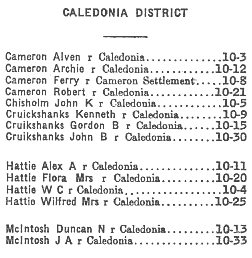
On 4 November 1971, the Camden MT Co. received official approval to lease six additional circuits from MT&T, with the point of connection being at Pole #56 in Truro, at the intersection of East Prince Street and Harmony Road.
On 1 December 1971, the Camden MT Co. received official approval to lease Pin Space on 73 poles owned by the Harmony MT Co., at a rate of 5 cents per pole per month. The Camden MT Co. required this space to string its circuits through the Harmony MT Co. territory, to reach the connection point to MT&T in Truro.
— Source: PUB Annual Report 1971
On 1 July 1958, the Canaan MT Co. put into effect a new rate schedule: for members, $1.15 per month for each telephone, and $2.15 per month for nonmembers.
The name of the Canaan Mutual Telephone Company appeared in the Halifax Chronicle-Herald on 3 April 2001, and in the Halifax Daily News on 4 April 2001, in the obituary of Borden Frederick Carter, 88, of Canaan, Kings County, former secretary of the company.
The Cloverville MT Co. connected to the North American telephone system at the MT&T exchange in Antigonish.
On 19 July 1962, the Cloverville MT Co. abandoned its territory and went out of business forever. At the time of the shutdown, the Cloverville MT Co. served five subscribers, using 1.8 miles 2.9 km of pole line it owned and another 1.8 miles 2.9 km of circuit strung on poles owned by the Fairmont MT Co.
See note 6
— Source: PUB Annual Report 1962
The Cobequid MT Co. was incorporated under the Rural Telephone Act on 8 June 1922.
During 1934, the Cobequid MT Co. spent $15.00 to replace one mile 1.6 km of pole line.
On 5 October 1974, Cobequid MT Co. abandoned its territory and went out of business forever. At the time of the shutdown, the company had thirteen circuits on 36 miles 58 km of pole line, serving 122 customers.
— Source: PUB Annual Report 1974
On 22 June 1961, the Cow Bay MT Co., sold its entire undertaking, including all property, rights-of-way, pole lines, and equipment, in working order, to MT&T for $1,259.30. On the same day, the Cow Bay MT Co. abandoned its territory and went out of business forever.
— Source: PUB Annual Report 1961
In 1960, the Doucettville MT Co. ceased operation and abandoned its territory. Telephone service in this area was taken over by MT&T.
— Source: PUB Annual Report 1960
During 1934, the Dunmore MT Co. spent $150.00 to replace 8 miles 13 km of pole line.
In 1960, the Earltown MT Co. abandoned 3.3 miles 5.3 km of telephone line.
In 1960, the East Chebogue MT Co. ceased operation and abandoned its territory. Telephone service in this area was taken over by MT&T.
— Source: PUB Annual Report 1960
During 1934, the Eastern Shore MT Co. spent $17.90 to replace 2 miles 3 km of pole line.
The East St. Andrews MT Co. connected to the North American telephone system at the MT&T exchange in Antigonish.
On 16 September 1962, the entire undertaking of the East St. Andrews MT Co., including all property, pole lines, rights-of-way, and equipment, in working order, was sold to MT&T for $2,725.00. On the same day, the East St. Andrews MT Co. abandoned its territory and went out of business forever.
See note 6
— Source: PUB Annual Report 1962
During 1934, the East Stewiacke MT Co. spent $180.00 to replace 12 miles 20 km of pole line.
— Source: PUB Annual Report 1934
In December 1922, the East Tracadie MT Co. was operating 2.5 miles 4.0 km of pole line.
In early 1966, the East Victory MT Co. abandoned that part of its territory "situate west of the intersection of Greenland Road and Victory Road and extending approximately 3.7 miles 6.0 km westerly along Greenland Road, Jefferson Road, and Middlesex Road".
On 15 December 1966, East Victory MT Co. abandoned the balance of its territory "being that portion which extends easterly from the intersection of Greenland Road and Victory Road along Victory Road for a distance of approximately 6.3 miles" 10.1 km. On the same day, East Victory MT Co. went out of business forever.
— Source: PUB Annual Report 1966
The East Wallace MT Co. was incorporated under the Rural Telephone Act on 18 August 1914. It connected with the North American telephone system at the MT&T exchange at Wallace.
On 16 November 1974, East Wallace MT Co. abandoned its territory and went out of business forever. At the time of the shutdown, the company had one circuit on 4 miles 6 km of pole line, and served 13 subscribers who paid 50 cents each, per month. The closure of the small telephone company's operation was caused by the plan to convert the MT&T Wallace Exchange in 1974 to dial operation with direct distance dialling, which would require all connecting companies, including this one, to choose between spending a lot of money to install new equipment or abandon the territory and let MT&T take over.
— Source: PUB Annual Report 1973, page 385
As of 1 February 1958, the Eden Lake MT Co.'s rate was, for members (shareholders), $3.50 per telephone per month; for nonmembers, $4.00 per telephone per month. The Company's share of long distance charges was 10 cents for each message to and from any point on its lines.
The charge for Emergency Service was 25 cents on each local and long distance message to and from points on the Company's telephone lines received or delivered during the hours set forth below. This Emergency Service charge was in addition to all regular charges.
|
As of 1 November 1971, the Eden Lake MT Co. put into effect a new rate schedule: for members (shareholders), $6.50 per telephone per month; for nonmembers, $7.00 per telephone per month. The Company's share of long distance charges remained at 10 cents for each message to and from any point on its lines. The Emergency Service hours remained as as above.
— Source: PUB Annual Report 1971
On 2 December 1973, Eden Lake MT Co. abandoned its territory and went out of business forever.
— Source: PUB Annual Report 1973, pages 3-4
The Evangeline MT Co. connected to the North American telephone system at the MT&T exchange in Saulnierville.
On 6 April 1962, the Evangeline MT Co. abandoned a portion of its assigned territory, along the highway from Hectanooga to Salmon River, between Lake Doucette Bridge and the junction of said highway with Highway #1, on the ground that no telephone line had ever been built to serve that area, and there was no prospect of one being built.
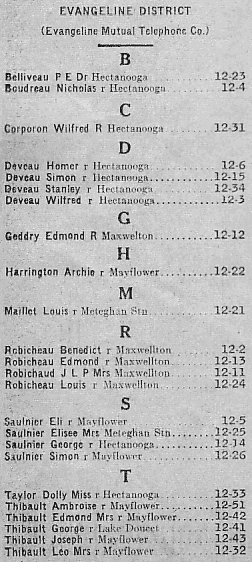
The Fairmont MT Co. connected to the North American telephone system at the MT&T exchange in Antigonish.
On 19 July 1962, the Fairmont MT Co. abandoned its territory and went out of business forever. At the time of the shutdown, the Fairmont MT Co. was a message rate company, serving seven subscribers with 7.6 miles 12.2 km of pole line.
See note 6
— Source: PUB Annual Report 1962
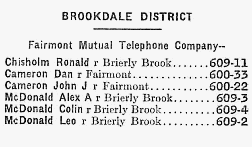
During 1934, the Falls MT Co. spent $34.96 to replace 5.3 miles 8.5km of pole line.
On 1 May 1962, the Falls MT Co. put into effect a new rate schedule: for members, $2.00 per telephone per month, and for nonmembers, $2.50 per telephone per month.
On 31 May 1922, the Five Island Lake MT Co. received official approval that the company's proportion of Local Call and Long Distance charges for messages to or from any point on its line would be 5 cents.
The Fox Brook MT Co. connected to the North American telephone system at the MT&T exchange in Hopewell.
On 24 January 1966, at a special general meeting, a two-thirds majority vote of the shareholders approved a resolution to abandon the business. At that time George W. Ross was the Secretary of the company.
On 22 September 1966, Fox Brook MT Co. abandoned its territory and went out of business forever; MT&T took over the territory.
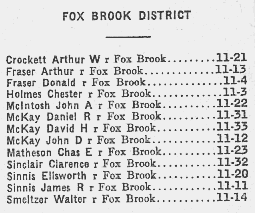
The Fox Harbour MT Co. was incorporated under the Rural Telephone Act on 28 January 1952, but had been operating a telephone service in that area since 1900. It connected with the North American telephone system at the MT&T Wallace Exchange.
On 16 November 1974, Fox Harbour MT Co. abandoned its territory and went out of business forever. At the time of the shutdown, the company had one circuit on 6.5 miles of its own pole line and about 5 miles of wire strung on poles belonging to another company. It served 6 member subscribers who each paid $1.50 per month for their telephones, and 2 nonmember summer subscribers who paid $2.70 each, per month. The closure of the small telephone company's operation was caused by the plan to convert the MT&T Wallace Exchange in 1974 to dial operation with direct distance dialling, which would require all connecting companies, including this one, to choose between spending a lot of money to install new equipment or abandon the territory and let MT&T take over.
Source: pages 386-387, PUB Annual Report 1973
On 1 November 1971, the French Cove MT Co. received official approval to lease one additional circuit, to supply service to additional customers.
On 16 December 1973, the French Cove MT Co. abandoned its territory and went out of business forever.
The Glengarry MT Co. connected to the North American telephone system at the MT&T Hopewell Exchange.
On 16 September 1973, Glengarry MT Co. abandoned its territory and went out of business forever; MT&T took over the territory.
Source: page 5, PUB Annual Report 1973
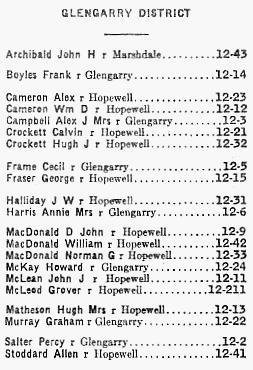
The Glen Road MT Co. connected to the North American telephone system at the MT&T exchange in Antigonish.
On 12 August 1962, the Glen Road MT Co. sold its entire undertaking, including all property, pole lines, rights-of-way, and equipment, in working order, to MT&T for $435.00. On the same day, the Glen Road MT Co. abandoned its territory and went out of business forever.
See note 6
— Source: PUB Annual Report 1962
The Grand River MT Co. connected to the L'Ardoise MT Co. which connected near St. Peter's to the MT&T network and the North American telephone system.
As of 1 October 1971, the Grand River MT Co. put into effect a new rate schedule: for members, $4.00 per business telephone per month and $3.50 per residence telephone per month; for nonmembers, $4.50 per business telephone per month and $4.00 per residence telephone per month. The Grand River MT Co. charged 15 cents per message on local calls to St. Peter's, originating at any point on the Company's lines; Grand River MT Co. kept 5 cents of this charge and the remaining 10 cents went to the L'Ardoise MT Co.
On 16 December 1973, the Grand River MT Co. abandoned its territory and went out of business forever.
During 1934, the Guysboro Intervale MT Co. spent $37.50 to replace 2.5 miles of pole line.
On 26 June 1962, the Harmony MT Co. received official approval to convert its system from four manually-operated message rate lines to five dial-operated flat rate lines.
On 12 October 1971, the Harmony MT Co. received official approval to lease twenty additional circuits from MT&T, with the point of connection being at Pole #56 in Truro, at the intersection of East Prince Street and Harmony Road; the purpose of these additional circuits being to supply service to new subscribers, reduce multi-party line fills, and to provide private line (one-party) and two-party service. On 1 December 1971, the Harmony MT Co. received official approval to lease Pin Space on 73 poles owned by Harmony MT Co., to the Camden MT Co. at a rate of 5 cents per pole per month.
In 1960, the Hastings MT Co. ceased operation and abandoned its territory. Telephone service in this area was taken over by MT&T.
— Source: PUB Annual Report 1960
The Hedgeville MT Co. was incorporated under the Rural Telephone Act on 6 December 1916. It connected to the North American telephone system at the MT&T exchange in River John.
On 21 September 1974, Hedgeville MT Co. abandoned its territory and went out of business forever. At the time of the shutdown, the company had 4.5 miles 7.2 km of pole line, serving six customers.
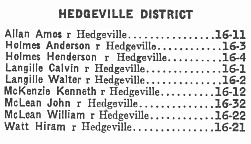
On 4 May 1962, the Hilden MT Co. received official approval to convert its system from four message rate manually operated lines, to fourteen flat rate dial operated lines.
During 1934, the Hillside MT Co. spent $90.00 to replace 8.9 miles of pole line.
On 8 January 1958, the Hillside MT Co. abandoned that portion of its territory "from Alex MacDonald's gate, Hillside, to Thomas Horns', at Horns Road, and to Alex MacAulay's, at Albert Bridge", on the ground that no telephone line had ever been built there and there was no prospect of any being built.
The Hodson MT Co. connected to the North American telephone system at the MT&T exchange in River John.
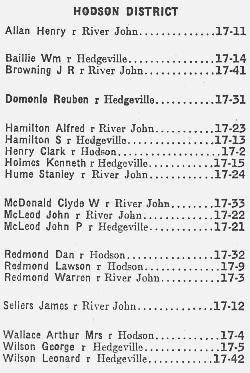
On 11 March 1966, at a special general meeting, a two-thirds majority vote of the shareholders approved a resolution to abandon the business. At that time Mrs. Dollina MacIntosh was the Secretary-Treasurer of the company. On 30 November 1966, Homeville MT Co. abandoned its territory and went out of business forever.
The Beaton Institute at UCCB holds 1923-1966 records of the Homeville MT Co.
[Source: http://beaton.uccb.ns.ca/MG14,200s.htm ]
The Jordan Bay MT Co. connected to the North American telephone system at the MT&T exchange in Shelburne.

On February 29, 1916, the Judique MT Co. received official approval that the Company's proportion of Local Toll and Long Distance charges for messages to or from any point on its line would be 5 cents.
The Lakevale MT Co. connected to the North American telephone system at the MT&T exchange in Antigonish.
On 1 July 1962, the Lakevale MT Co. sold its entire undertaking, including all property, pole lines, rights-of-way, and equipment, in working order, to MT&T for $900.00. On the same day, the Lakevale MT Co. abandoned its territory and went out of business forever.
See note 6
— Source: PUB Annual Report 1962
Note: In some records, the name is spelled "Lake View", and in others "Lakeview".
Service area: In Richmond County, Lake View.
During 1934, the Lakeview MT Co. spent $180.00 to replace twelve miles nineteen km of pole line.
On 9 April 1958, the Lakeview MT Co. received official approval to enlarge its territory "from Mrs. Bessie MacKay's, West Bay, to Mr. R.N. MacInnes', Marshes, West Bay", a distance of about four miles about six km.
On 16 December 1973, the Lake View MT Co. abandoned its territory and went out of business forever.
The Lakeview Mutual Telephone Company's name appeared in the Halifax Sunday Herald on 9 May 2004, in an article on bank balances left behind when groups disband or become inactive. In a sidebar listing "unclaimed bank balances," Lakeview Mutual Telephone appeared with an unclaimed balance of $4,326.99 at St. Peter's, in an account that has been inactive since August 1980. This was by far the largest unclaimed balance listed in Nova Scotia.
[It was still there on 26 February 2006.]
Unclaimed balances are listed at: Bank of Canada, Unclaimed Bank Balances
http://bank-banque-canada.ca/
The Grand River MT Co. connected to the L'Ardoise MT Co. which connected to the MT&T network.
On 8 August 1918, the L'Ardoise MT Co. was incorporated under the Rural Telephone Act.
On 1 February 1962, the L'Ardoise MT Co. put into effect a new rate schedule: For members, $10.00 per year for a residence telephone, and $15.00 per year for a business phone; for nonmembers, $15.00 per year for each phone.
On 16 December 1973, the L'Ardoise MT Co. sold its entire undertaking, including all property, pole lines, rights-of-way, and equipment, in working order, to MT&T for $260.00. On the same day, the L'Ardoise MT Co. abandoned its territory and went out of business forever. On the day of the shutdown, the L'Ardoise MT Co. was serving 97 subscribers on twenty lines, with 17.3 miles 27.9 km of pole line.
The Lorne MT Co. may have been the oldest of the Mutual Telephone Companies. It is the only Mutual Telephone Company listed in the 1912 Annual Report of the Public Utilities Board, which reported the names of all 77 Nova Scotian telephone companies in existence on 31 December 1912. However, the 1917 Annual Report of the PUB states that Lorne MT Co. was incorporated in 1917. (This may not be a contradiction, perhaps the Lorne MT Co. operated for several years as an informal – not legally incorporated – association.)
On 16 September 1973, Lorne MT Co. abandoned its territory and went out of business forever.
The Lower LaHave M.T. Company is known to have been in existence in 1915; it is named in the 1915 Annual Report of the Public Utilities Board, in the list of Telephone Companies Incorporated Under the Rural Telephone Act. This company does not appear in the 1912 list.
In 1965, Mrs. W. Wolfe was Secretary-Treasurer of the Company.
On 21 November 1965, the Lower LaHave MT Co. abandoned its territory and went out of business forever. The territory was taken over by the Maritime Telegraph & Telephone Company (MT&T), and was included in the Riverport Exchange Area.
Source: The Public Utilities Board Annual Report for 1965.
The Lower River M.T. Company is known to have been in existence in 1943; it is named in the 1943 Annual Report of the Public Utilities Board, in the list of Telephone Companies Incorporated Under the Rural Telephone Act. This company does not appear in the 1939 list.
In 1965, Father E.N. Tobin was Secretary-Treasurer of the Company.
On 6 December 1965, the Lower River MT Co. abandoned its territory and went out of business forever. The territory was taken over by the Maritime Telegraph & Telephone Company (MT&T), and was included in the Port Hawkesbury Exchange Area.
Source: The Public Utilities Board Annual Report for 1965.
The Malagash MT Co. was incorporated under the Rural Telephone Act on 5 May 1925, but had been operating a telephone service in that area since 1904. It connected with the North American telephone system at the MT& exchange in Wallace.
On 16 November 1974, Malagash MT Co. abandoned its territory and went out of business forever. At the time of the shutdown, the company had one circuit on 13 miles 21 km of its own pole line and about 3 miles 5 km of wire strung on poles belonging to another company. It served 33 member subscribers who each paid $20.00 per year for their telephones, and 7 nonmember subscribers who paid $2.50 each, per month. The closure of the small telephone company's operation was caused by the plan to convert the MT&T Wallace Exchange in 1974 to dial operation with direct distance dialling, which would require all connecting companies, including this one, to choose between spending a lot of money to install new equipment or abandon the territory and let MT&T take over.
Source: pages 388-389, PUB Annual Report 1973
The Malagawatch MT Co. was incorporated under the Rural Telephone Act on 1 August 1922.
On 15 July 1974, Malagawatch MT Co. abandoned its territory and went out of business forever. At the time of the shutdown, the company had two circuits on 22 miles 35 km of pole line, and served 29 subscribers who paid $10.00 each, per year.
The Marydale & Beauly MT Co. connected to the North American telephone system at the MT&T exchange in Antigonish.
On 16 September 1962, the Marydale & Beauly MT Co. sold its entire undertaking, including all property, pole lines, rights-of-way, and equipment, in working order, was sold to MT&T for $1,200.00. On the same day, the Marydale & Beauly MT Co. abandoned its territory and went out of business forever.
See note 6
— Source: PUB Annual Report 1962
The Meadow Green & Pomquet River MT Co. connected to the North American telephone system at the MT&T exchange in Antigonish.
On 16 September 1962, the Meadow Green & Pomquet River MT Co. sold its entire undertaking, including all property, pole lines, rights-of-way, and equipment, in working order, to MT&T for $975.00. On the same day, the Meadow Green & Pomquet River MT Co. abandoned its territory and went out of business forever.
See note 6
— Source: PUB Annual Report 1962
On 18 March 1966, at a special general meeting, a two-thirds majority vote of the shareholders approved a resolution to abandon the business. At that time Louis L. Roberts was the Secretary-Treasurer of the company. On 30 November 1966, Melville MT Co. abandoned its territory and went out of business forever.
During 1934, the Middle River & Hunters Mountain MT Co. spent $30.00 to replace 2 miles 3 km of pole line.
The Beaton Institute at UCCB holds 1929-1941 records of the Middle River & Hunters Mountain MT Co.
[Source: http://beaton.uccb.ns.ca/MG14.htm ]
On 21 December 1973, the Middle River MT Co. abandoned its territory and went out of business forever.
On 16 December 1966, the Milford MT Co. received official approval to lease two additional circuits from MT&T, with the point of connection being at the Annapolis Central Office.
The Beaton Institute at UCCB holds 1939-1951 records of the Mineral Rock MT Co.
[Source: http://beaton.uccb.ns.ca/MG14.htm ]
In May 2004, the Mineral Rock Mutual Telephone Company had an unclaimed balance of $541.50 in a Sydney bank account that had been inactive since February 1975.
[It was still there on 26 February 2006.]
Source: Bank of Canada, Unclaimed Bank Balances
http://bank-banque-canada.ca/
During 1934, the Mira River MT Co. spent $185.41 to replace 9 miles of pole line.
On 8 January 1958, the Mira River MT Co. sold its entire undertaking, including all property, pole lines, rights-of-way, and equipment, in working order, to MT&T for $200.00. On that same day, the Mira River MT Co. abandoned its territory and went out of business forever.
On 7 February 1922, the Mooseland MT Co. received official approval that the company's proportion of Local Call and Long Distance charges for messages to or from any point on its line would be 10 cents.
On 1 October 1958, the Mooseland MT Co. put into effect a new rate schedule, of $2.00 per month for each telephone. This rate replaced the previous rate which had been in effect since 31 December 1943. Under the new rate, the MMT Co's share of long distance charges, for calls to and from points on its lines, was ten cents.
For several days in April 1936, the Moose River Gold Mines MT Co. Ltd. was the most famous telephone company in North America (it certainly had more media mentions in Canada and the United States than any other telephone company then in existence). The one-wire ground-return telephone line operated by the MRGMMT Co. carried J. Frank Willis' round-the-clock commentary on the progress of the effort to rescue three men trapped in a cave-in of the Moose River Mine, broadcast live on hundreds of radio stations in Canada and the U.S.A.
The cave-in occurred at 11pm on 12 April 1936. Frank Willis made his first broadcast report from the mine site at 6pm on April 20 – then for two minutes every half-hour he was live on air throughout North America. He continued for 56 hours straight, 111 consecutive live broadcasts, making his last broadcast at 2am on April 23. An estimated 100 million people were listening. The broadcasts were carried on all 58 radio stations then in existence in Canada, and on an estimated 650 stations in the United States. The BBC picked up the broadcasts for Great Britain and Europe. It was North America's very first live 24-hour news event. During this time, Willis' only link to the outside world was the Moose River Gold Mines Mutual Telephone Company's single number-nine iron wire. Before each broadcast, Willis had to convince everyone on the 18-mile-[29km]-long party-line phone circuit to put down the phone and listen to his reports on the radio. Otherwise, the signal was so weakened that his voice came through no louder than a thin whisper.
Source:
CBC Archives: Moose River Mine Disaster
http://archives.cbc.ca/IDC-1-70-672-3860-20/that_was_then/disasters_tragedies/moose_river
|
Ten Major Technological Innovations That Have Been Significant To The CBC Number One: The Moose River Disaster, 12 April 1936 Archived: 1997 May 27 http://web.archive.org/web/19970527042013/http://www.cbc.ca/aboutcbc/history/milestones/milestones/milestones.html Archived: 1997 July 22 http://web.archive.org/web/19970722062841/http://www.cbc.ca/aboutcbc/history/milestones/milestones/milestones.html Archived: 1997 October 14 http://web.archive.org/web/19971014090305/http://www.cbc.ca/aboutcbc/history/milestones/milestones/milestones.html |
On 30 September 1958, the New Chester MT Co. put into effect a new rate schedule, replacing the previous rate which had been in effect since 11 January 1955. The new rate was $3.00 per telephone per year for members (shareholders); for non members $22.80 per year for each residence telephone, and $27.60 per year for each business telephone. Under the new rate, the New Chester MT Co's share of long distance charges, for calls to and from points on its lines, was 10 cents.
The New Cornwall MT Co. connected to the North American telephone system at the MT&T exchange in Mahone Bay.
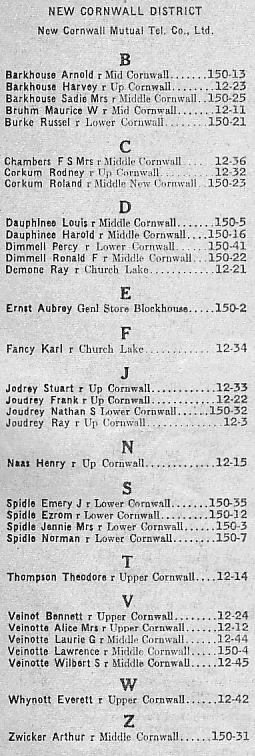
The New Riverside MT Co. connected to the North American telephone system at the MT&T exchange in Antigonish.
On 12 August 1962, the New Riverside MT Co. abandoned its territory and went out of business forever. At the time of the shutdown, the New Riverside MT Co. was a flat rate company, serving twelve subscribers with 5.2 miles 8.4 km of pole line.
See note 6
— Source: PUB Annual Report 1962
During 1934, the New Truro Road MT Co. spent $14.44 to replace 0.9 mile of pole line.
In 1922, the New Victoria MT Co. kept its bank account at the Bank of Nova Scotia in Oxford.
On March 7, 1916, the Nine Mile River & Rawdon MT Co. received official approval that the Company's proportion of Local Toll and Long Distance charges for messages to or from any point on its line would be 10 cents. During 1934, the Nine Mile River & Rawdon MT Co. spent $20.83 to replace one mile of pole line.
The North Shore MT Co. connected to the North American telephone system at the MT&T exchange in Antigonish.
On 15 February 1962, the North Shore MT Co., sold its entire undertaking, including all property, pole lines, rights-of-way, and equipment (except telephone sets) to MT&T for $10,000.00. On the same day, the North Shore MT Co. abandoned its territory and went out of business forever.
See note 6
— Source: PUB Annual Report 1962
The North Wallace MT Co. was incorporated under the Rural Telephone Act on 13 October 1913. It connected with the North American telephone system at the MT&T exchange in Wallace.
On 16 November 1974, North Wallace MT Co. abandoned its territory and went out of business forever. At the time of the shutdown, the company had 10 miles 16 km of its own pole line and about 4 miles 6 km of wire strung on poles belonging to another company. It served 17 subscribers; shareholders paid 50 cents per month for their telephones and non-shareholders paid $1.00 per month. The closure of the small telephone company's operation was caused by the plan to convert the MT&T Wallace Exchange in 1974 to dial operation with direct distance dialling, which would require all connecting companies, including this one, to choose between spending a lot of money to install new equipment or abandon the territory and let MT&T take over.
Source: page 387, PUB Annual Report 1973
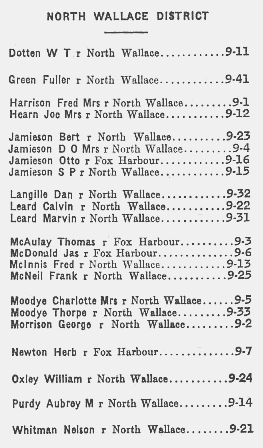
On 1 June 1962, the Nuttby & North River MT Co. Ltd. abandoned its territory and went out of business forever.
On 16 December 1973, the Oban MT Co. Ltd. abandoned its territory and went out of business forever.
The Piedmont Valley MT Co. was incorporated in 1960, under the Nova Scotia Rural Telephone Act.
Source: page xxxvi, PUB Annual Report 1960
On 1 March 1961, the Piedmont Valley MT Co. revised its rates to:
for members (shareholders), $25.00 per telephone per year;
for nonmembers, $30.00 per telephone per year.
For each long-distance call, to or from PVMT Co., the company got 5 cents as its share of the long-distance charge.
Source: PUB Annual Report 1961
On 1 February 1962, the PVMT Co. revised its rates to:
for members, $27.00 per telephone per year;
for nonmembers, $32.00 per telephone per year.
The long distance share remained at 5 cents.
Source: PUB Annual Report 1962
The Pinevale MT Co. was incorporated under the Rural Telephone Act on 1 April 1924.
On 5 October 1974, Pinevale MT Co. abandoned its territory and went out of business forever. At the time of the shutdown, the company had one line 7.3 miles long and served five subscribers.
Source: page 369, PUB Annual Report 1973
During 1934, the Pleasant Bay MT Co. spent $101.67 to replace 4 miles of pole line.
On July 4, 1916, the Pomquet MT Co. received official approval that the Company's proportion of Local Toll and Long Distance charges for messages to or from any point on its line would be 10 cents.
On 30 November 1966, Port Lorne MT Co's entire undertaking, including all property, rights-of-way, pole lines, and equipment, in working order, was sold to MT&T for $64.20. On the same day, the Port Lorne MT Co. abandoned its territory and went out of business forever.
— Source: PUB Annual Report 1966
In 1960, the Prairie & Petit Etang MT Co. ceased operation and abandoned its territory. Telephone service in this area was taken over by MT&T.
— Source: PUB Annual Report 1960
On 9 July 1962, the Red Islands MT Co. Ltd. adopted a new rate schedule: $1.75 per month for members (shareholders), and $3.00 per month for nonmembers. The Company's share of long distance charges for calls to and from points on its lines was 10 cents per call.
On 16 December 1973, the Red Islands MT Co. Ltd. abandoned its territory and went out of business forever.
On 6 October 1916, the River Bourgeois MT Co. received official approval that the Company's proportion of Local Toll and Long Distance charges for messages to or from any point on its line would be 5 cents.
John Joseph Samson (1863-1942) was the first president of the River Bourgeois MT Co.
[Source: http://www.mindspring.com/~giammo/Bissett/wga31.html ]
On 12 May 1961, the River Bourgeois MT Co. was given official approval to enlarge the boundaries of the territory it served, by extending a line from its then-existing terminus westward 1.3 miles 2.1 km to serve the district of Hawker.
On 19 May 1974, the River Bourgeois MT Co. Ltd. abandoned its territory and went out of business forever.
On 22 February 1973, the Riversdale MT Co. received official approval to lease two additional circuits connecting with MT&T, and on 1 May 1973 for two more circuits, and on 1 June 1973 for one more circuit, making a total of five additional circuits.
On 13 November 1957, Riverside MT Co. abandoned ten miles of its existing telephone lines.
During 1934, the River View MT Co. spent $138.44 to replace 5.2 miles of pole line.
During 1934, the Roseway River MT Co. spent $122.50 to replace 8 miles of pole line.
During 1934, the Roslin MT Co. spent $59.06 to replace 2.2 miles of pole line.
On 31 December 1973, the Ross Ferry MT Co. abandoned that portion of its territory in Victoria County, on Boularderie Island along the Hillside Road between Church Road and Steele's Cross Road, a distance of about 3.5 miles.
On 2 May 1916, the Round Island MT Co. received official approval that the Company's proportion of Local Toll and Long Distance charges for messages to or from any point on its line would be 5 cents.
On 30 November 1966, the Round Island MT Co. Ltd. abandoned its territory and went out of business forever.
The Beaton Institute at UCCB holds 1957-1968 records of the Round Island MT Co.
[Source: http://beaton.uccb.ns.ca/MG14,100s.htm ]
During 1934, the Sable River MT Co. spent $68.28 to replace 2.4 miles of pole line.
On 1 February 1958, the Sable River MT Co. put into effect a new rate schedule: For members (shareholders), 50 cents per month when the telephone was supplied by the member, and $1.00 per month when the telephone was supplied by the Company; and for nonmembers, 75 cents per month when the telephone was supplied by the nonmember, and $1.50 per month when the telephone was supplied by the Company. The Company's share of long distance charges was 10 cents for each message to and from any point on its lines.
The St. Catherine MT Co. was incorporated on 3 October 1917.
In a decision rendered on 6 February 1958, the Public Utilities Board wrote: "...the Board is satisfied that although the St. Catherine Mutual Telephone Company Limited was incorporated under the Rural Telephone Act, it did not function as a mutual telephone company and was in fact operated in a private manner by one W.A. Kinney for a period of twelve years. ...the Kinney line, so-called, was later acquired by one H.C. Burgess in 1942 and ... Burgess provided telephone service in the area until his death in 1956..."
On 31 January 1958, "the administrator and heirs-at-law of the late H.C. Burgess ... relinquished all rights ... to supply telephone service" in this area.
The St. Joseph's MT Co. connected to the North American telephone system at the MT&T exchange in Antigonish.
During 1934, the St. Joseph's MT Co. spent $52.50 to replace 3.5 miles of pole line.
On 16 September 1962, the St. Joseph's MT Company's entire undertaking, including all property, pole lines, rights-of-way, and equipment, in working order, was sold to MT&T for $4,000.00. On the same day, the St. Joseph's MT Co. abandoned its territory and went out of business forever.
See note 6
— Source: PUB Annual Report 1962
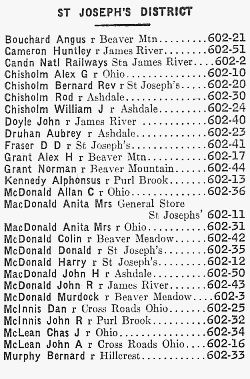
The Salmon River MT Co. connected to the North American telephone system at the MT&T Guysboro Exchange.
On 15 March 1966 the Salmon River MT Co. Ltd. abandoned its territory and went out of business forever. (The date was definitely 15 March, but the PUB's records are in some conflict about the year, which may have been either 1966 or 1967.)
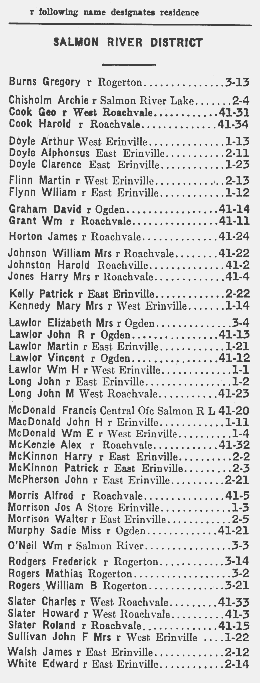
The Scotts Bay MT Co. connected to the North American telephone system at the MT&T exchange in Canning.
The Seafoam MT Co. connected to the North American telephone system at the MT&T exchange in River John.
On 30 November 1966, Seafoam MT Co. abandoned its territory and went out of business forever.
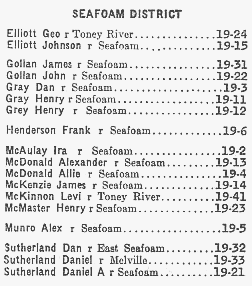
During 1934, the Ship Harbour Lake MT Co. spent $197.26 to replace 8.9 miles 14.3 km of pole line.
On 16 December 1966, the Ship Harbour Lake MT Co. received official approval to lease five additional circuits from MT&T, with the point of connection being in Lake Charlotte.
On 17 April 1973, the Ship Harbour MT Co. put into effect a new rate schedule.
a shareholder in the company. |
The name of the Ship Harbour Lake Mutual Telephone Company appeared in the Halifax Chronicle-Herald, 29 June 2002, on page B2, in an item about the Memory Lane Heritage Village in Lake Charlotte.
The Shulee MT Co. connected to the North American telephone system at the MT&T exchange at River Hebert.
On 1 February 1962, the South Branch MT Co. adopted a new rate schedule, $6.00 per year (the telephone to be furnished by the subscriber).
The South Lochaber MT Co. was incorporated under the Rural Telephone Act on 8 January 1914. It connected to the North American telephone system at the MT&T exchange in Antigonish.
On 16 September 1962, the South Lochaber MT Co. adopted a new rate schedule, $24.00 per telephone per year.
On 5 October 1974, South Lochaber MT Co. abandoned its territory and went out of business forever. At the time of the shutdown, the company had five circuits on 48 miles 77 km of pole line, and served 43 member subscribers and 26 nonmember subscribers.
Source: page 369, PUB Annual Report 1973
The South River MT Co. was incorporated under the Rural Telephone Act on 29 August 1913. It connected to the North American telephone system at the MT&T exchange in Antigonish.
On 5 October 1974, South River MT Co. abandoned its territory and went out of business forever. At the time of the shutdown, the company had sixteen circuits on 36 miles 58 km of pole line, and served 97 subscribers.
Source: page 369, PUB Annual Report 1973

On February 29, 1916, the South West Margaree MT Co. received official approval that the Company's proportion of Local Toll and Long Distance charges for messages to or from any point on its line would be 5 cents.
The Springfield MT Co. connected to the North American telephone system at the MT&T exchange in Antigonish.
On 16 September 1962, the Springfield MT Co. sold its entire undertaking, including all property, pole lines, rights-of-way, and equipment, in working order, was sold to MT&T for $1,100.00. On the same day, the Springfield MT Co. abandoned its territory and went out of business forever.
See note 6
— Source: PUB Annual Report 1962
On 1 November 1973, the Springside MT Co. put into effect a new schedule of rates, $3.50 per month for a residence telephone, and $4.00 per month for a business telephone. These rates applied for members (shareholders) – no rates were stated for nonmembers, which strongly suggests that this company had no nonmember subscribers at that time.
On 1 February 1962, the Spry Bay MT Co. adopted a new rate schedule: For members (shareholders), $10.00 per telephone per year, and for nonmembers, $27.00 per telephone per year. The Company's share of long distance charges was 10 cents per call, for messages to or from any point along its lines.
The Telford MT Co. connected to the North American telephone system at the MT&T exchange in New Glasgow.
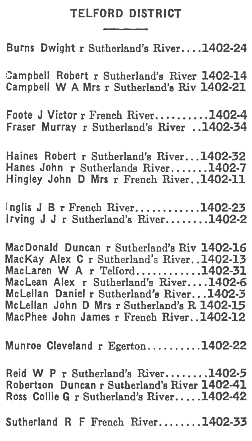
On 19 January 1959, the Three Brooks MT Co. abandoned its territory and went out of business forever.
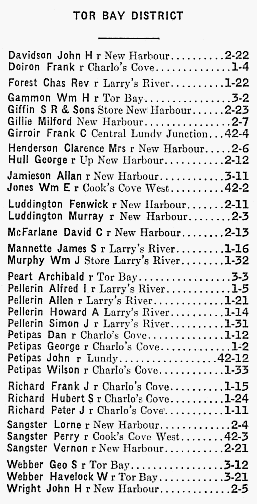
On 4 June 1961, the Township Line MT Co. abandoned its territory and went out of business forever.
It is not now known when the Upper Meadowville M.T. Company was formed. In most of its Annual Reports, the Public Utilities Board included a list of the Mutual Telephone Companies in existence in Nova Scotia on 31 December in the year of the Report. The Upper Meadowville M.T. Company does not appear in the 1943 list, or in any list before 1943.
In 1965, Charles W. Haslam was Secretary of the Company.
On 6 July 1965, the Upper Meadowville MT Co. abandoned its territory and went out of business forever. The territory was taken over by the Maritime Telegraph & Telephone Company (MT&T) and was included in the Pictou Exchange Area, and the former Meadowville Exchange Area was cancelled.
Source: The Public Utilities Board Annual Report for 1965.
The Wallace & Wentworth M.T. Co. Ltd. was incorporated under the Rural Telephone Act on 27 July 1949, as successor to the Wallace & Wentworth Telephone Company, an unincorporated company which had served the area for some sixty years previously. The Wallace & Wentworth MT Co. connected with the North American telephone system at the MT&T Wallace Exchange.
On 16 November 1974, Wallace & Wentworth MT Co. abandoned its territory and went out of business forever. At the time of the shutdown, the company had two circuits on 3.5 miles of pole line. It served 24 member subscribers who each paid $1.60 per month, and 13 nonmember subscribers who paid "$2.00 plus" per month. At the time of the shutdown, MT&T took over the existing plant of the Wallace & Wentworth MT Co. but paid "nothing" for it. The closure of the small telephone company's operation was caused by the plan to convert the MT&T Wallace Exchange in 1974 to dial operation with direct distance dialling, which would require all connecting companies, including this one, to choose between spending a lot of money to install new equipment or abandon the territory and let MT&T take over.
Source: pages 390-391, PUB Annual Report 1973
The Wallace Point MT Co. was incorporated under the Rural Telephone Act on 6 February 1917. It connected with the North American telephone system at the Wallace Exchange of MT&T.
On 16 November 1974, Wallace Point MT Co. abandoned its territory and went out of business forever; MT&T took over the territory. At the time of the shutdown, the company had one circuit on 2 miles of pole line. It served five subscribers who each paid 50 cents per month for a residential telephone, and 70 cents per month for a business telephone. The closure of the small telephone company's operation was caused by the plan to convert the MT&T Wallace Exchange in 1974 to dial operation with direct distance dialling, which would require all connecting companies, including this one, to choose between spending a lot of money to install new equipment or abandon the territory and let MT&T take over.
Source: page 389, PUB Annual Report 1973
On 15 February 1962, the Wentworth Valley MT Co. sold its entire undertaking, including all property, pole lines, rights-of-way, and equipment, in working order, to MT&T for $193.00. On that same day, the Wentworth Valley MT Co. abandoned its territory and went out of business forever.
During 1925, the Westerly MT Co. "wholly replaced and renewed" one-half mile [about one km] of its pole line, and "reset" six miles [ten km] of its pole line. The company withdrew $34.00 from its bank account in Tatamagouche to "help defray the cost of such rebuilding and resetting."
— Source: PUB Annual Report 1925, page 132
During 1934, the West Middle River MT Co. spent $91.50 to replace 5.7 miles 9.2 km of pole line.
During 1934, the West New Annan MT Co. spent $20.00 to replace 1.3 miles 2.1 km of pole line.
During 1934, the West River MT Co. spent $102.95 to replace 4.2 miles 6.8 km of pole line.
On 6 March 1934, the White Brook MT Co. received approval of this rate schedule: Subscribers (shareholders) $6.00 per year, payable monthly. There was no mention of a rate for non-subscribers, and it may be inferred there were no non-subscribers.
On 16 September 1961, the White Rock MT Co. abandoned its territory and went out of business forever.
On 13 November 1961, the Williams Point MT Co. abandoned its territory and went out of business forever.
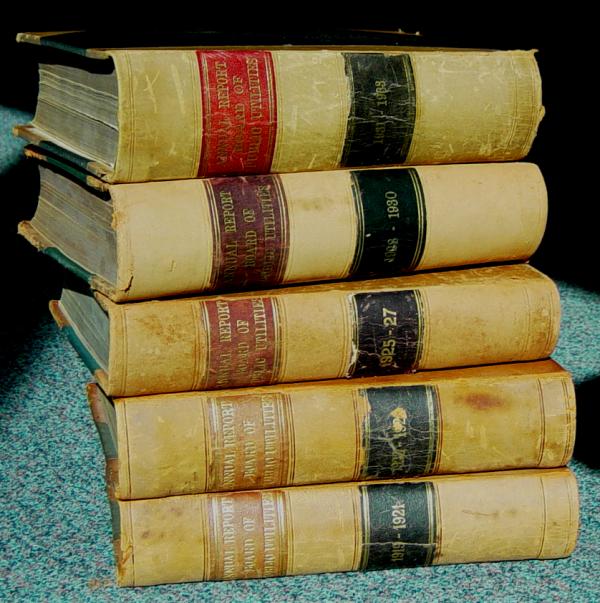
• Balls Creek Mutual Telephone Co. Ltd.
• Blomidon Mutual Telephone Co. Ltd.
• Brooks Mutual Telephone Co. Ltd.
• Enon & Terra Nova Mutual Telephone Co. Ltd.
• Groves Point Mutual Telephone Co. Ltd.
• Lorne Mutual Telephone Co. Ltd.
• New Truro Road Mutual Telephone Co. Ltd.
• Pennant Mutual Telephone Co. Ltd.
• Queensville Mutual Telephone Co. Ltd.
• St. Catherine Mutual Telephone Co. Ltd.
• Seafoam Mutual Telephone Co. Ltd.
• Toney River Mutual Telephone Co. Ltd.
• Wallace Point Mutual Telephone Co. Ltd.
• West Branch Mutual Telephone Co. Ltd.
Source: pages 10-11, PUB annual report 1917
• Bailey's Brook Mutual Telephone Company Limited
• Big Island Mutual Telephone Company Limited
• Piedmont Valley Mutual Telephone Company Limited
Source: page xxxvi, PUB annual report 1960
• Antigonish Harbour Mutual Telephone Company [1 July 1962]
• Brierly Brook Mutual Telephone Company [12 August 1962]
• Brookdale Mutual Telephone Company [12 August 1962]
• Cloverville Mutual Telephone Company [19 July 1962]
• East St. Andrews Mutual Telephone Company [16 September 1962]
• Fairmont Mutual Telephone Company [19 July 1962]
• Glen Road Mutual Telephone Company [12 August 1962]
• Lakevale Mutual Telephone Company [1 July 1962]
• Marydale and Beauly Mutual Telephone Company [16 September 1962]
• Meadow Green and Pomquet River Mutual Telephone Company [16 September 1962]
• New Riverside Mutual Telephone Company [12 August 1962]
• North Shore Mutual Telephone Company [15 February 1962]
• St. Joseph's Mutual Telephone Company [16 September 1962]
• Springfield Mutual Telephone Company [16 September 1962]
Source: PUB annual report 1962
The mutual telephone campanies and small telephone utilities continue to render important service in their rural areas which as a rule are thinly populated. Although the quality of service is usually of a lesser standard than that supplied by a large commercial company, the rates are correspondingly low; in any case these areas are not often attractive from a purely commercial viewpoint due to their sparsely settled nature and length of lines required to provide service.
Many of the mutual companies were established in the first quarter of this century through cooperative effort on the part of their members in order to provide themselves with party-line telephone service at reasonable rates. In order to accomplish this objective, donated labour, poles and other materials was customary, but such practice is now becoming rare and today all labour and materials must be purchased for cash in most cases. This fact places a severe strain on these small public utilities with low rate of income, while increases in rates is somewhat limited by the recognized inferior quality of service.
It follows that improvement and extension of existing rural services is a real problem, while at the same time there is increasing demand from rural residents for such improvement. Many persons today are no longer content with multi-party shared in some cases among twenty or more subscribers, and requests for private-line service are increasing. At present there is very little service of this type furnished by small companies and the capital cost of providing same must be borne by the applicants in accordance with the Rural Telephone Act.
Loans and subsidies from the provincial government available to mutual companies as well as withdrawals from their compulsory reserve funds have been of real assistance to such companies, although necessarily limited in extent. This type of aid is not available to private rural companies as a rule, which feel the economic pressure and service demands even more acutely ... Two of the larger rural companies (Carleton and Coastal) found it necessary to discontinue ... during the year.
There was fortunately no major storm damage suffered in 1958, although highway construction continued to raise problems in some areas.
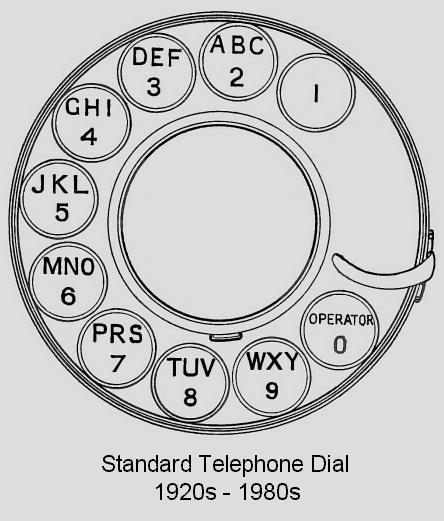
The rotary telephone dial, as used for about seven decades – the 1920s through the 1980s – was a circular device provided on ordinary telephones to enable the user to communicate to the central exchange equipment the telephone number he/she wanted to be connected to. The above diagram shows the dial design. There were ten holes, each of a size to comfortably accomodate an adult index finger, arranged in a circle. Each hole corresponds to a numerical digit, and eight holes also were labelled with alphabetic letters (as shown).
First we will describe the dial operation for a numerical-digit phone number (ignoring the letters for now). The method of operation is for the user first to lift his/her receiver – this releases the cradle switch and establishes an active connection with the exchange equipment. Then, taking as an example he/she wants to call "3708", he/she will enter (dial) these four digits in turn, one at a time. To enter 3 he/she places his/her finger in the hole labelled "3", rotates the front plate of the dial (which is free to rotate in a clockwise direction) until his/her finger and the finger hole for 3 reach the finger stop shown on the right-hand side of the diagram above. He/she then withdraws his/her finger and the rotary plate automatically rotates back to the rest position – driven by a spring that was wound up as the user turned the dial clockwise. As the dial rotates counterclockwise, back to the rest position, the internal mechanism operates a switch that opens and closes the circuit three times. This transmits three pulses of electric current to the exchange equipment, which recognises this as the digit "3". To enter the next digit 7, he/she will now insert his/her finger in the hole labelled "7" and repeat the procedure. The remaining digits are entered in sequence. The impulses are transmitted on the return (counterclockwise) motion, because this is not controlled by the user and the timing of the impulses can be spaced precisely at the rate of ten impulses per second. If the impulses were transmitted on the user-controlled clockwise motion, the timing would be unpredictable, with the user turning the dial sometimes slowly, sometimes quickly, sometimes hesitatingly.
The 24 letters (omitting Q and Z) serve only as a way to make it easier for people to remember long telephone numbers. The telephone equipment recognizes only the numerical digits, not the letters (see "Telephone Exchange Names" below).
Beginning in the mid-1980s, the rotary dial was replaced by push-button "touch-tone" keypads. By the mid-1990s, rotary dial telephones were rare in Canada.
When mentioning telephone numbers, novels and stories written in the 1940s and 1950s often use exchange names. There is a 1940 Glenn Miller song called "PEnnsylvania 6-5000," and Elizabeth Taylor starred in the 1960 movie "BUtterfield 8" — both titles are derived from telephone exchange names.
In 2006, the phone number PEnnsylvania 6-5000 (736-5000) still works (within area code 212) to reach the Hotel Pennsylvania, 401 Seventh Avenue, New York.
In the 1948 movie Sorry, Wrong Number, starring Barbara Stanwyck and Burt Lancaster, the telephone number BOwery 2-1000 appears repeatedly.
In Alfred Hitchcock's Rear Window, released in 1954, James Stewart as L.B. Jefferies makes a phone call to Lars Thorwald's apartment, CHelsea 2-7099.
In Alfred Hitchcock's North By Northwest, released in 1959, Cary Grant as Roger Thornhill, while at a police station after his arrest for drunk driving, makes a phone call to BUtterfield 8-1098.
In the movie Ocean's Eleven, — released in 1960 but written in the late 1950s — Frank Sinatra as Danny Ocean places a call to DUdley 2-6969. The phone number ELdorado 5-9970 appears four times in the 1962 movie The Manchurian Candidate — also written in the late 1950s.
The phone numbers CRestview 5-1733 and GLAdstone 9281 appear in the 1950 movie Sunset Boulevard, starring William Holden, Gloria Swanson, and Erich von Stroheim. In the 1959 movie Some Like It Hot, starring Tony Curtis, Jack Lemmon and Marilyn Monroe, Joe the saxophone player (Tony Curtis) calls phone number WABash 1098.
In the movie Rebel Without a Cause, released in 1955, Natalie Wood as Judy, while at a police station, tells an officer to make a phone call to LExington 0-5549.
For many years, "LOnesome 7-7203" has been a favourite country and western song. Two other
songs with named exchange numbers in their titles, "BEechwood 4-5789" and "ECho Valley 2-6809", have been recorded. (Note: In "ECho Valley", the V is capitalized but not dialed.)
The custom was to capitalize the significant letters to make them stand out – the remainder of the name was irrelevant. PEnnsylvania 6-5000 would be dialed as PE6-5000. LIberty 3-2424 would be dialed as LI3-2424, and JUniper 2-7201 as JU2-7201.
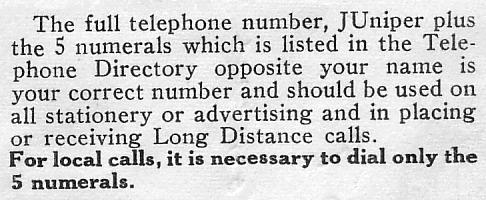

In The Simpsons, the long-running animated TV show, many episodes have telephone numbers in the 2L5N form, including:
KL5-1680, KL5-2226, KL5-2233, KL5-3223, KL5-3226,
KL5-3457, KL5-3700, KL5-4796, KL5-5246, KL5-5472.
KLondike5 was not a random choice. It was selected on purpose, because KL5 translates to 555, the 'safe' exchange for telephone numbers displayed in movies and on television. KL5 has the advantage that few viewers will realize this is an alternate form of the familiar '555' exchange number.
Letters Digit ======= ===== A B C 2 D E F 3 G H I 4 J K L 5 M N O 6 P R S 7 T U V 8 W X Y 9Thus "CEntral 4-5678" is dialed as 234-5678. Letter C in "CEntral" is for digit 2, letter E is for digit 3. The "ntral", the lower-case part of "CEntral", was ignored (not for dialing).
The above is excerpted from the volumnious FAQ file of Telecom Digest,
at http://hyperarchive.lcs.mit.edu/telecom-archives/ which is provided
courtesy of the Laboratory for Computer Science at the Massachusetts Institute of Technology
|
This 'telephone' has too many limitations to be seriously considered as a practical form of communication. The device is inherently of no value to us.
— Western Union internal memo, 1878
Added
2002 Sep 22: Commercial Cable Co. Ltd.
2003 Feb 19: Lower River Mutual Telephone Co. Ltd.
2003 Feb 21: Upper Meadowville Mutual Telephone Co. Ltd.
2003 Mar 23: Riverport Telephone Co.
2003 Mar 29: Blomidon Mutual Telephone Co. Ltd.
2003 Mar 30: Bass River Telephone Co.
2003 Apr 18: Hants & Halifax Electric Telegraph Co.
2003 Apr 18: Truro & Pictou Electric Telegraph Co.
2003 Sep 25: Nova Scotia & Newfoundland Junction Telegraph Co.
2004 Dec 15: Medford Farmers Telephone Co.
2005 Jan 29: Pictou & Cape Breton Electric Telegraph Co.
2005 Apr 17: Bailey's Brook Mutual Telephone Co. Ltd.
2005 Apr 17: Big Island Mutual Telephone Co. Ltd.
2005 Apr 18: Dominion Government Telegraph & Telephone Service
2005 Apr 18: East Chebogue Mutual Telephone Co. Ltd.
2005 Apr 18: Lorne Rural Telephone Co. Ltd.
2005 Apr 18: Prairie & Petit Etang Mutual Telephone Co. Ltd.
2005 Apr 30: Canadian National Telegraph Co.
This includes the main paper and the linked Historical Notes provided for some companies. This paper, with the linked Historical Notes, may be copied or printed for non-commercial purposes, or reproduced on WWW sites so long as it is 100% intact with author credit, citations, and text, including this notice. And please include the date on which you made the copy, because this is a work in progress.
|
Wayback Machine http://web.archive.org/index.html "Use the Wayback Machine to view web sites from the past." History of Telegraph and Telephone Companies in Nova Scotia The Wayback Machine has copies of this webpage from the early days: Archived: 2000 August 19 http://web.archive.org/web/20000819085812/http://epe.lac-bac.gc.ca/100/205/300/nova_scotias_electronic_attic/07-04-09/www.littletechshoppe.com/ns1625telephon.html Archived: 2000 December 7 http://web.archive.org/web/20001207015200/http://www.alts.net/ns1625/telephon.html Archived: 2000 December 17 http://web.archive.org/web/20001217030800/http://www.littletechshoppe.com/ns1625/telephon.html Archived: 2001 February 8 http://web.archive.org/web/20010208225559/http://www.alts.net/ns1625/telephon.html Archived: 2001 June 7 http://web.archive.org/web/20010607223715/www.alts.net/ns1625/telephon.html Archived: 2001 August 3 http://web.archive.org/web/20010803130838/http://www.alts.net/ns1625/telephon.html Archived: 2001 October 30 http://web.archive.org/web/20011030184506/http://epe.lac-bac.gc.ca/100/205/300/nova_scotias_electronic_attic/07-04-09/www.littletechshoppe.com/ns1625telephon.html Archived: 2002 June 12 http://web.archive.org/web/20020612023239/http://www.alts.net/ns1625/telephone.html Archived: 2002 November 08 http://web.archive.org/web/20021108172455/http://www.littletechshoppe.com/ns1625/telephone.html Archived: 2003 June 08 http://web.archive.org/web/20030608232134/http://www.littletechshoppe.com/ns1625/telephone.html Archived: 2003 December 28 http://web.archive.org/web/20031228160216/http://www.alts.net/ns1625/telephone.html Note: In the above URLs before 2002, the file name is "telephon" (with the final 'e' missing). Why did I use this peculiar mis-spelling of the central name in this webpage? The answer is that this webpage was first established in 1996, when there was a limit of eight characters to the length of all computer file names. This was the infamous "8 dot 3" rule, meaning file names were restricted to 8 characters (maximum) for the file name with a 3-character (max) extension. The eight-character limit on file names was relaxed in the late 1990s, but changing a URL is not something to be done casually. Changing a URL, even by adding one letter, invalidates all links pointing toward the page. However, in this case I decided to change, in January 2002, to the full nine-character spelling for 'telephone' (with a forwarding address posted at the old location for forty months). |
|
|
W3C CSS Validation Service |
